Comets
Comet Hale-Bopp
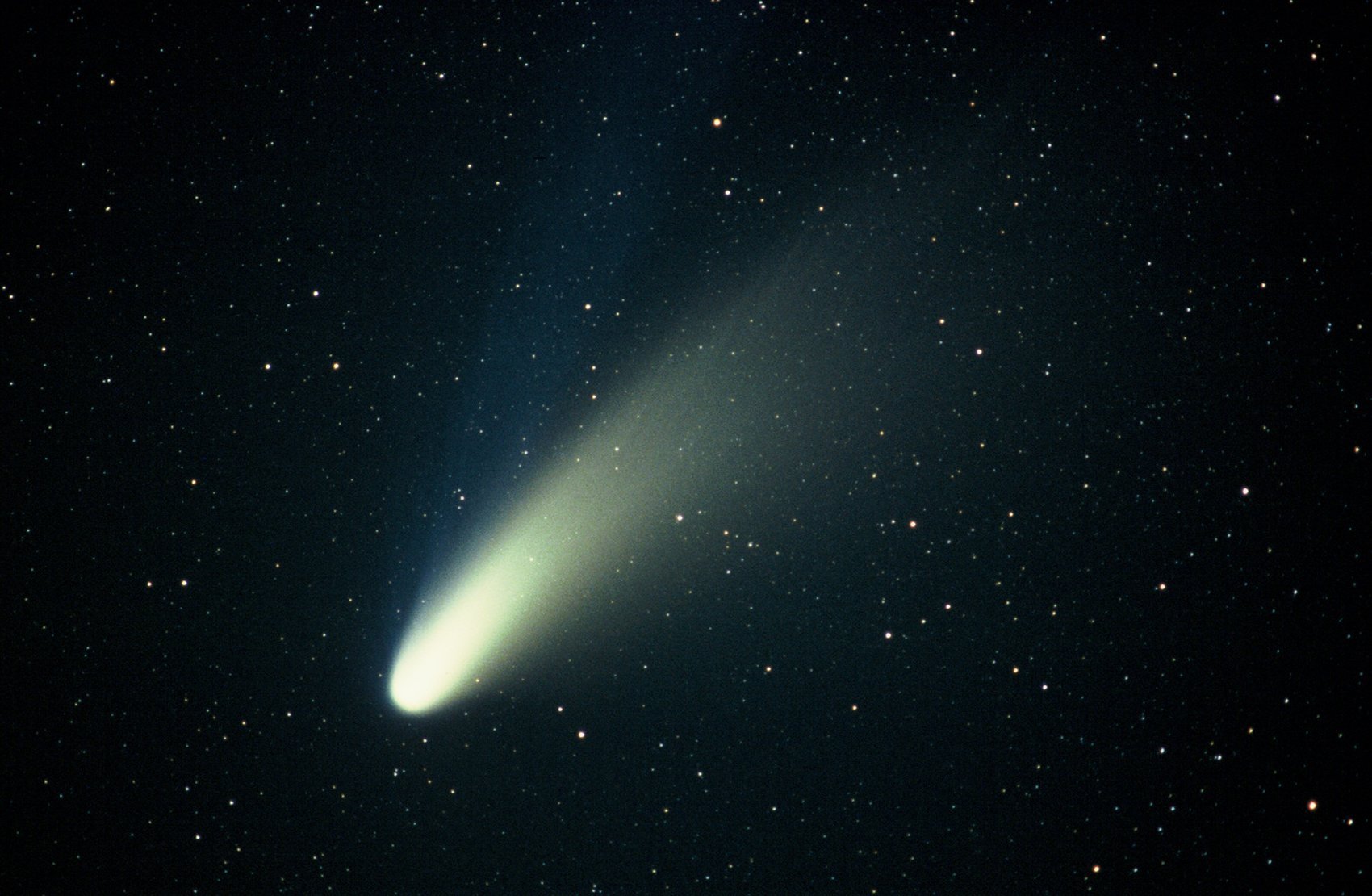
Comet Hale-Bopp - Taken on March 16, 1997. This is a single six minute exposure using a 35mm Nikon camera and a 300mm lens at f/4.5. The film was Kodak Elite II ASA 400 slide film. The camera was riding piggyback on my C-11. The photo was taken in a hay field near Fayetteville NC.
Back to the top of the pageBack to Mark's Astrophotography Home
Comet Hyakutake
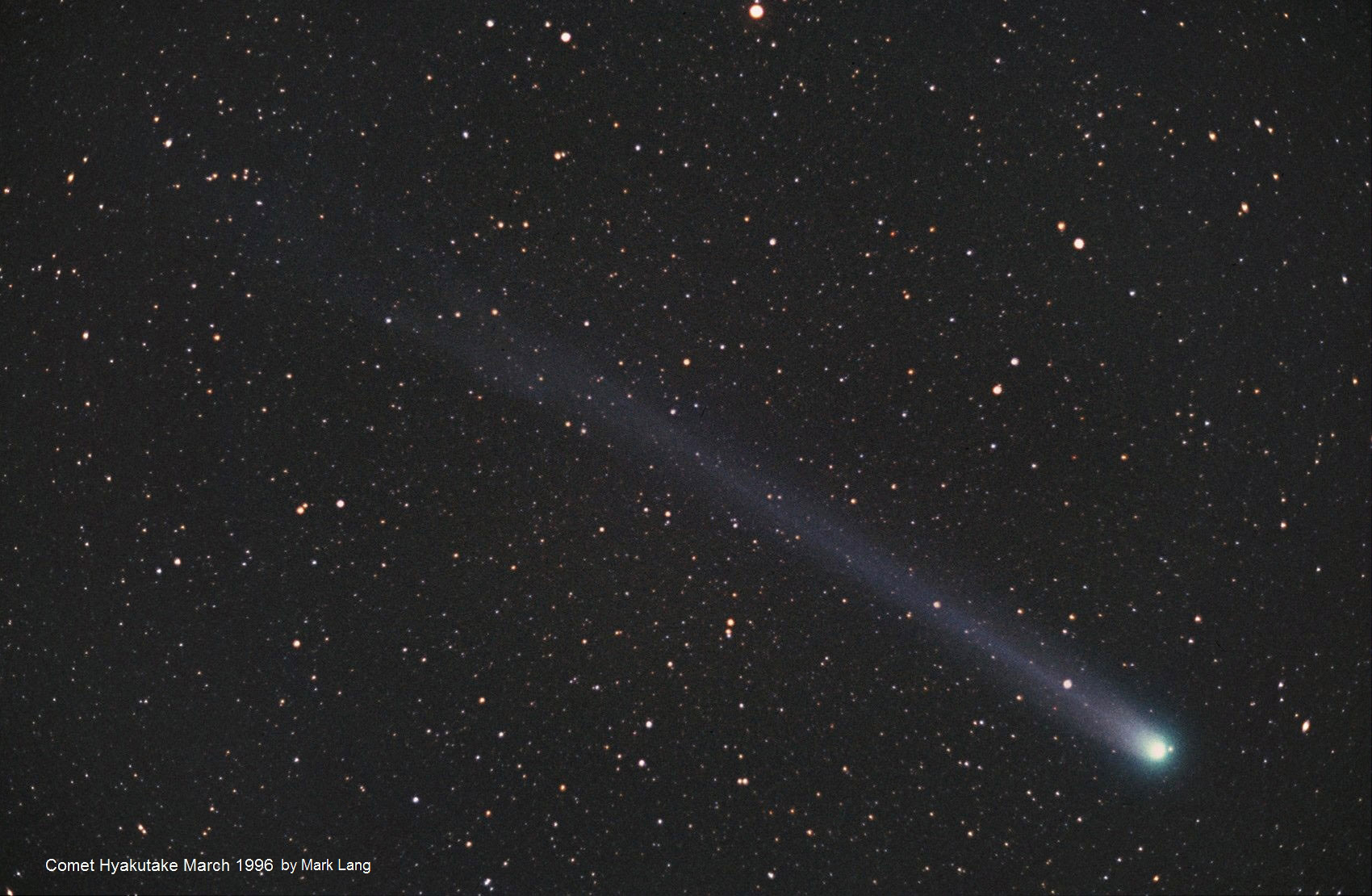
Comet Hyakutake - Taken March 23, 1996 using an Olympus 35mm camera, a 50mm lens, and Scotchchrome ASA 400 color slide film. Exposure time was between 5 and 10 minutes. Taken at the New Hope Overlook at Jordan Lake.
Back to the top of the pageBack to Mark's Astrophotography Home
Comet Holmes

Comet Homes - Taken Oct., Nov., and Dec. 2007. During the fall of 2007 Comet
Holmes unexpectedly brightened among the stars of Perseus. The mosaic below was
created from the best of my images. I started with my Celestron C-11 in the
beginning when the nucleus was small, then started using the Genesis refractor
when the comet got large. The images are shown to the same scale and
orientation. I used my unmodified Canon Rebel XT to acquire the images.
Click on the image for a larger view in a new window.
Back to Mark's Astrophotography Home
Comet Halley
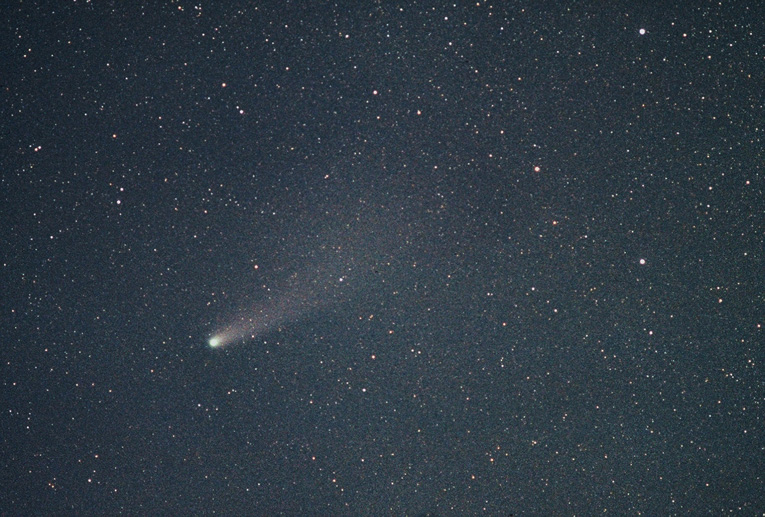
Comet Halley on March 22, 1986. After a scheduled public observing session at the WRAL soccer fields, I headed to a nearby dark site and photographed Comet Halley with my Olympus OM-1 and a 135mm lens. The brighter stars in the upper right of the photo are part of the handle of the teapot of Sagittarius.
Back to the top of the pageBack to Mark's Astrophotography Home
Comet West
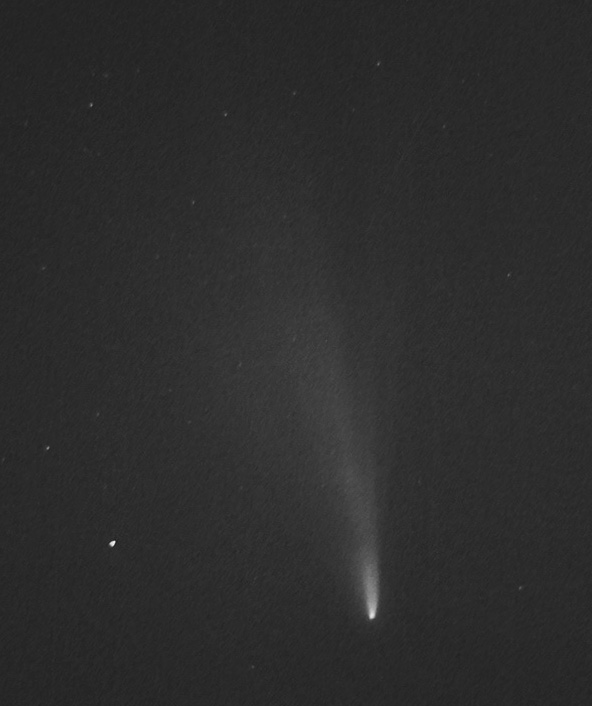
Comet West March 6, 1976.
This is my first comet photo. It was taken off Kildaire Farm Road in Cary before sunrise. I was using my father's 35mm camera with a 205mm lens and Kodak Tri-x film. If I had only had a driven telescope mount at the time, this photo would have been really neat. The bright star left of the comet is Enif in Pegasus. The tail is roughly 5 degrees long in this photo. Comet West visually was one of the best comets I have ever seen. Only Comet Hale-Bopp and maybe Comet Hyakutake were better.
Back to the top of the page
Back to Mark's Astrophotography Home
Comet Lovejoy C/2014 Q2 - Jan. 10, 2015

Comet Lovejoy taken on Jan. 10, 2015 through the Genesis 5" f/5 refractor at the Bigwoods site. The night was frigid for central NC with the temperature at time of image capture of about 21 degrees. The comet seemed to be around magnitude 4 and which made it visible to the naked eye, but no tail was seen naked eye. The tail structure in the photo is quite interesting showing multiple streamers. This is a cropped view showing only the area around the coma and inner tail. The left to right area covers around 1.25 degrees in this cropped image. North is up. The comet was tracked during it's northward movement causing the streaked stars. The image is made up of 13 individual one minute exposures. Images were captured with Backyard EOS then reduced, average combined, and DDP stretched using ImagesPlus. The image was then taken to Photoshop CS2 for some additional levels and curves.
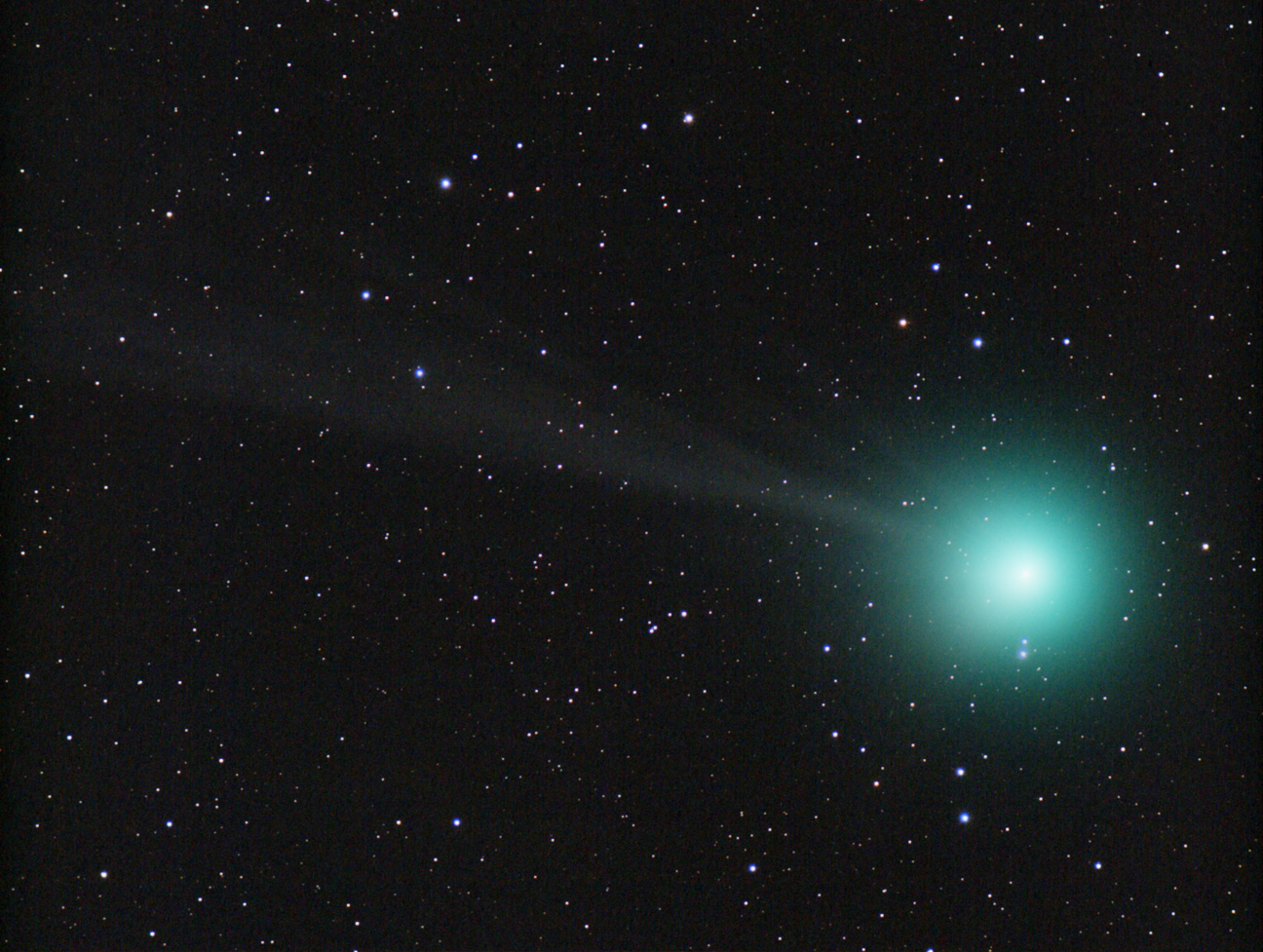
Another view of Comet Lovejoy using the same data as above, but this time aligned on the stars. This view makes a more pleasing photo, but at the expense of some detail in the tail structure seen above.
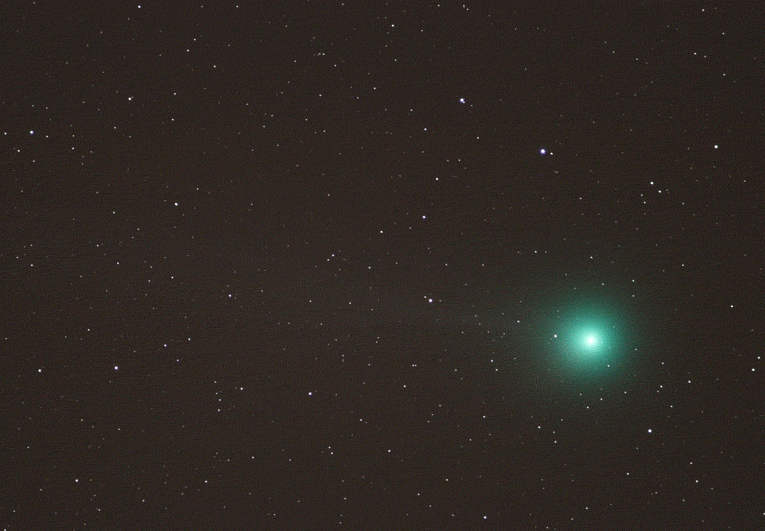
Comet Lovejoy on January 16, 2015, but this time the images were made into a 20 minute time lapse animation. Fourty 60 second exposures were taken through the Genesis that night, but only every other photo of the series was included into the animation. There were no darks nor flats applied. The CR2 images were just aligned then converted to jpg and taken to Photoshop to make the animation. The frames were cropped to keep the animation size managable.
Back to the top of the pageBack to Mark's Astrophotography Home
Comet ISON - Nov. 8, 2013
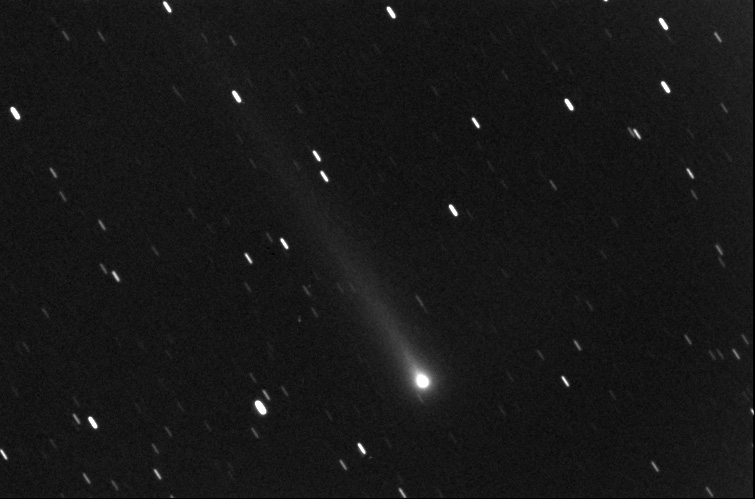
Comet ISON taken on 11/08/2013 5:30 am from Cary, NC. This photo is a combination of 15 exposures of 30 seconds each aligned on the comet nucleus. It was taken with my 4" Genesis refractor and my SBIG ST-402 CCD camera unguided but tracked. Visually, we could not see the comet through the scope at 25x. Low altitude and lots of light pollution hampered the visual effort. We were looking almost directly over a street light.
Back to the top of the page
Back to Mark's Astrophotography Home
Comet Jacques - Aug. 27, 2014
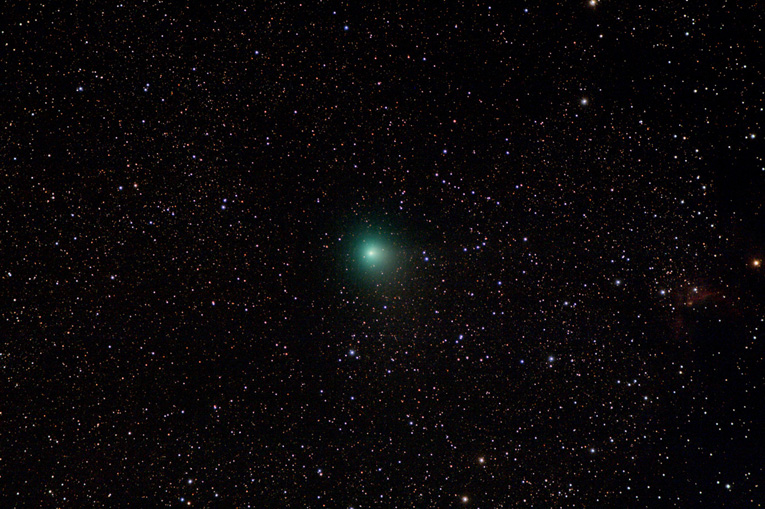
This image of Comet Jacques (C/2014 E2) was taken on Aug. 27, 2014 at the Bigwoods site.
It is a combination of 10x1 minute exposures using my Genesis 4" f/5 refractor and my Canon XTi at ISO 800.
I captured the data using Backyard EOS, and processed it in ImagesPlus 5.75a.
This was my first attempt of using masking techniques to combine a comet aligned set of images
and a star aligned set of images.
The red object on the right side of the frame is the Cave Nebula (Caldwell 9).
At the time the image was taken, the comet was in Cepheus near Iota Cepheus.
North is to the left in this image.
There was no sign of a tail in the images nor visually in a couple of scopes that night.
Click on the image for a 1200x800 view in a new window.
Back to Mark's Astrophotography Home
Comet Catalina Jan. 18, 2016
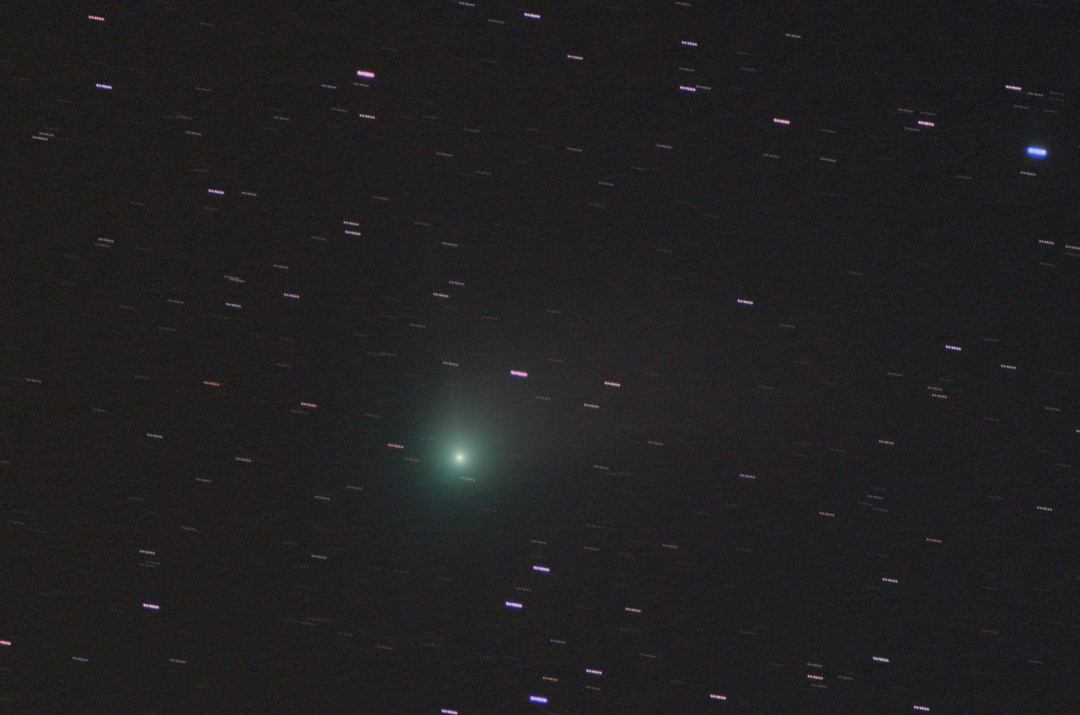
Another look at Comet Catalina taken from my front yard in Cary about a month after my
previous attempt shown below.
Due to all the light pollution, both tails are much harder to see.
The ion tail points up and the dust tail sweeps out to the right side.
Visually through the 4", the comet looked like a fuzzy ball.
I was unable to locate it using my 8x50 binoculars.
I took 6 x 90 seconds images using my Canon XTi at ISO 800 through the 4" f/5 Televue Genesis.
The comet was high in the sky near Mizar and Alcor which are bright stars in the Big Dipper.
The photos were taken around 4 am with the temperature around 28 degrees F.
Click on the image to see a larger version in a new window.
Back to Mark's Astrophotography Home
Comet Catalina December 15, 2015
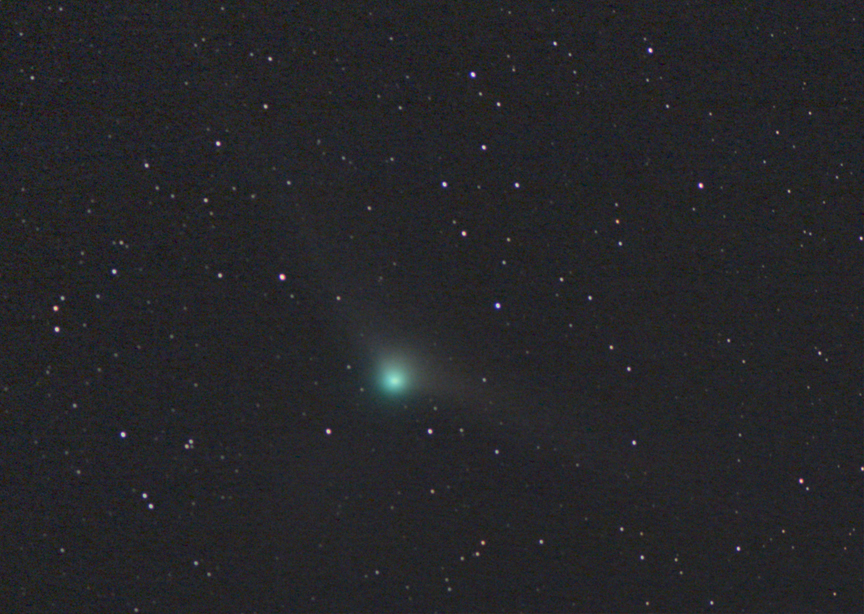
Comet Catalina taken from my front yard in Cary.
6 x 45 seconds and 5 x 30 seconds using my Canon XTi at ISO 800 through the 4" f/5 Televue Genesis.
Imaging was done around 5:50am so morning twilight had technically started, but the skies were still
fairly dark.
I was shooting over a streetlight and through Cary and Raleigh light pollution.
I used light and dark frames only. I should have taken the time to shoot flats also.
Click on the image to see a larger version in a new window.
Back to Mark's Astrophotography Home
Comet 41P, M97, and M108 - Mar. 22, 2017
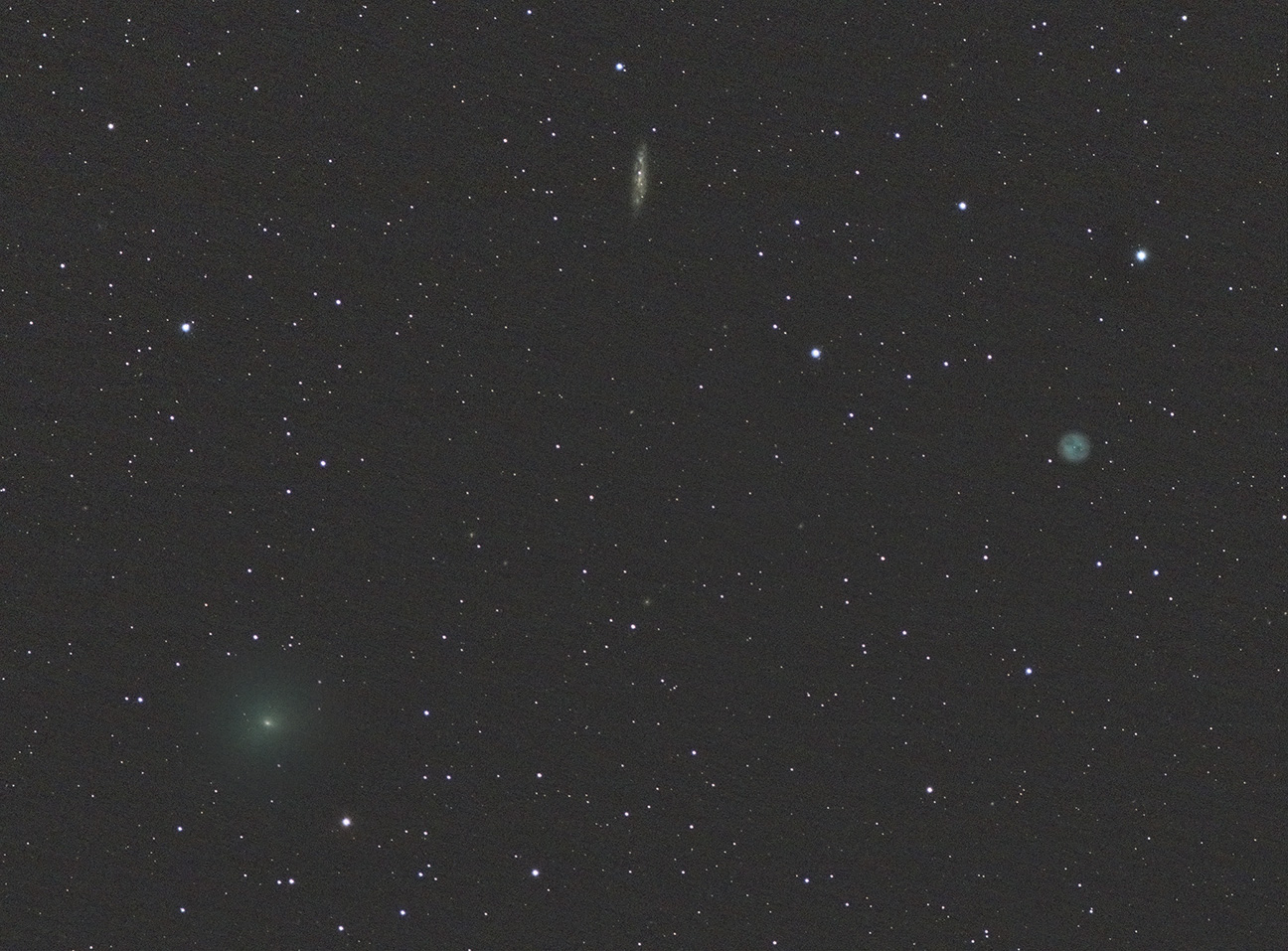
Comet 41P near M97 (the Owl Nebula) and galaxy M108 in Ursa Major.
North is to the left on the photo.
The comet was rapidly moving during the duration of the hour long photo shoot.
This is a combination of 40 x 45 second photos taken at ISO 800
with my modified Canon XTi camera.
I also took 11 each dark, flat, and bias frames.
I used my Televue Genesis 4" f/5 refractor on the Losmandy G-11 mount.
The shots were unguided.
I shot this in my driveway in Cary, NC.
The original data was reprocessed in May 2020 and presented here.
The images were captured with ByEos; calibrated, reduced, and aligned with PixInsight;
then taken to Photoshop 2020 to align the comet stacked images with the star stacked images.
Photoshop was also used for noise reduction and resizing.
Click on the image to see a larger version in a new window.
Back to Mark's Astrophotography Home
Comet Johnson - May 14, 2017
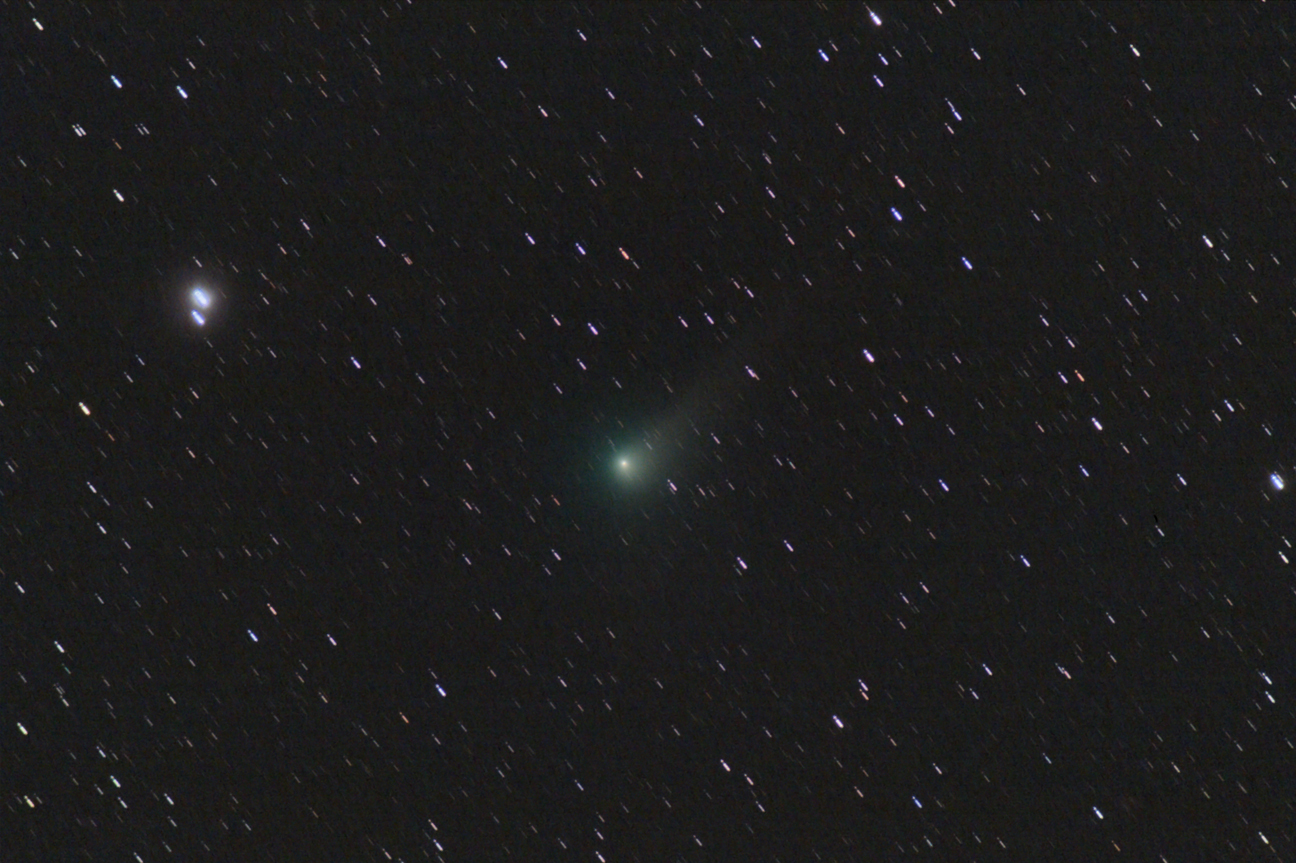
Comet C/2015 V2 Johnson.
This image was taken at Bigwoods on a mostly clear and breezy spring night.
The comet was near the two bright stars Mu1 and Mu2 Bootes.
It's brightness was reported to be about mag. 7 and the tail is about 20 arc-minutes long.
I was able to detect it visually tonight, but it was very faint in the 4" refractor.
Two nights later in my 8" f/10 SCT at home in Cary, it was barely detectable through our light pollution.
Backyard EOS was used to capture 25 x 1 minute unguided exposures at ISO 1600.
The images were combined and stretched using ImagesPlus and then taken to Photoshop CS2 for final processing.
I used my Televue Genesis 4" f/5 refractor, an old Canon XTi, and my Losmandy G-11 mount.
Click on the image for a larger view in a new window.
Back to Mark's Astrophotography Home
Comet C/2006 P1 McNaught - Jan. 10, 2007
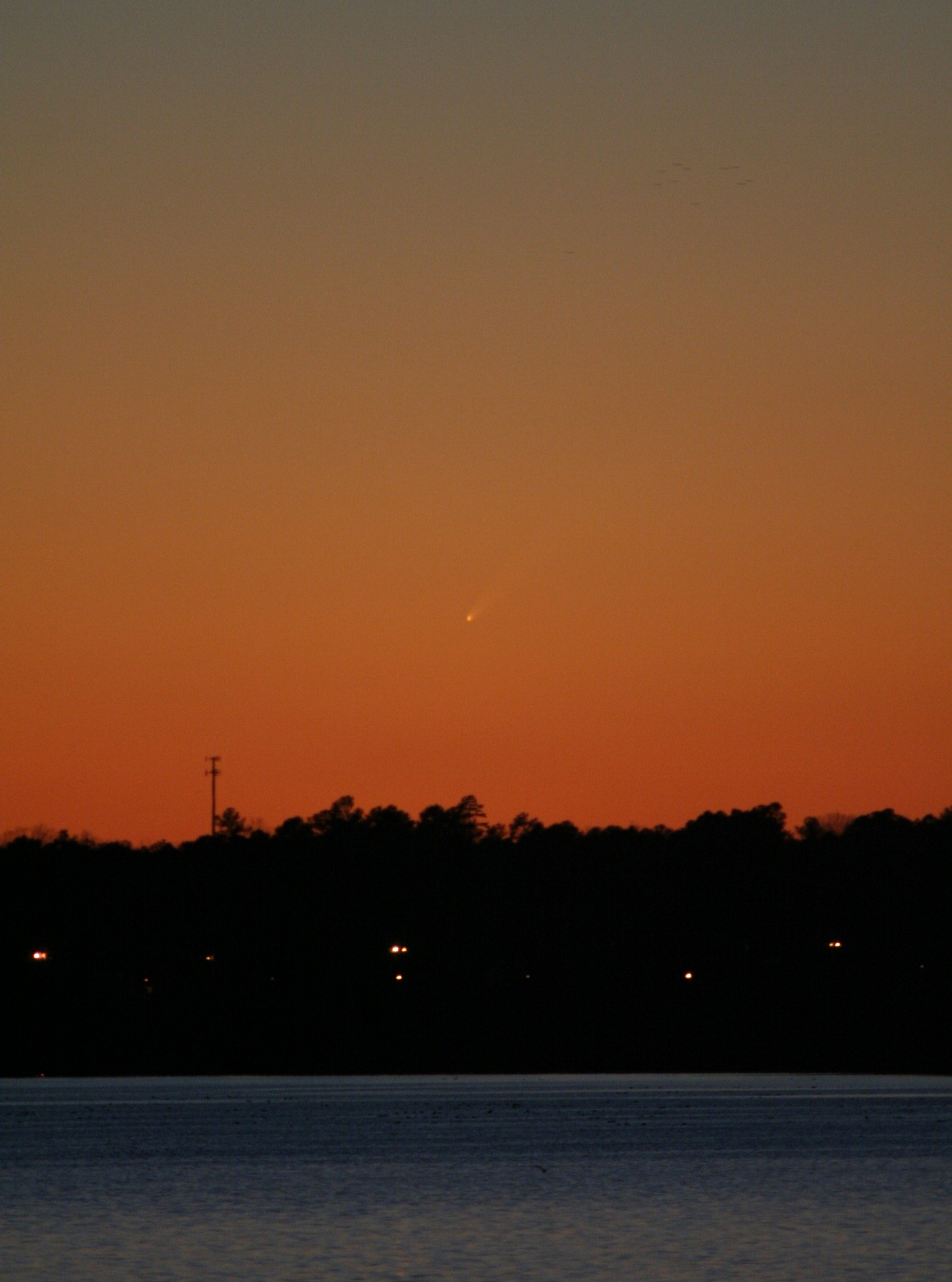
Comet McNaught - probably the brightest comet we never got to see very well.
This is my best photo taken just before it went around the sun and became visible in the
southern hemisphere where it became a spectacular sight.
It was only a bit over a degree above the west horizon in this photo.
This is a single cropped image from my tripod mounted Canon XT DSLR equipped with a 300mm lens.
It was taken on a cold January afternoon - that's right afternoon about 5:55pm - from Lake Crabtree in Cary.
The exposure was 1/30 of a second (!) at ISO 800 at f/4.5.
Click on the image for a larger view in a new window.
Back to Mark's Astrophotography Home
Comet 21P/Giacobini-Zinner - Sept. 7, 2018
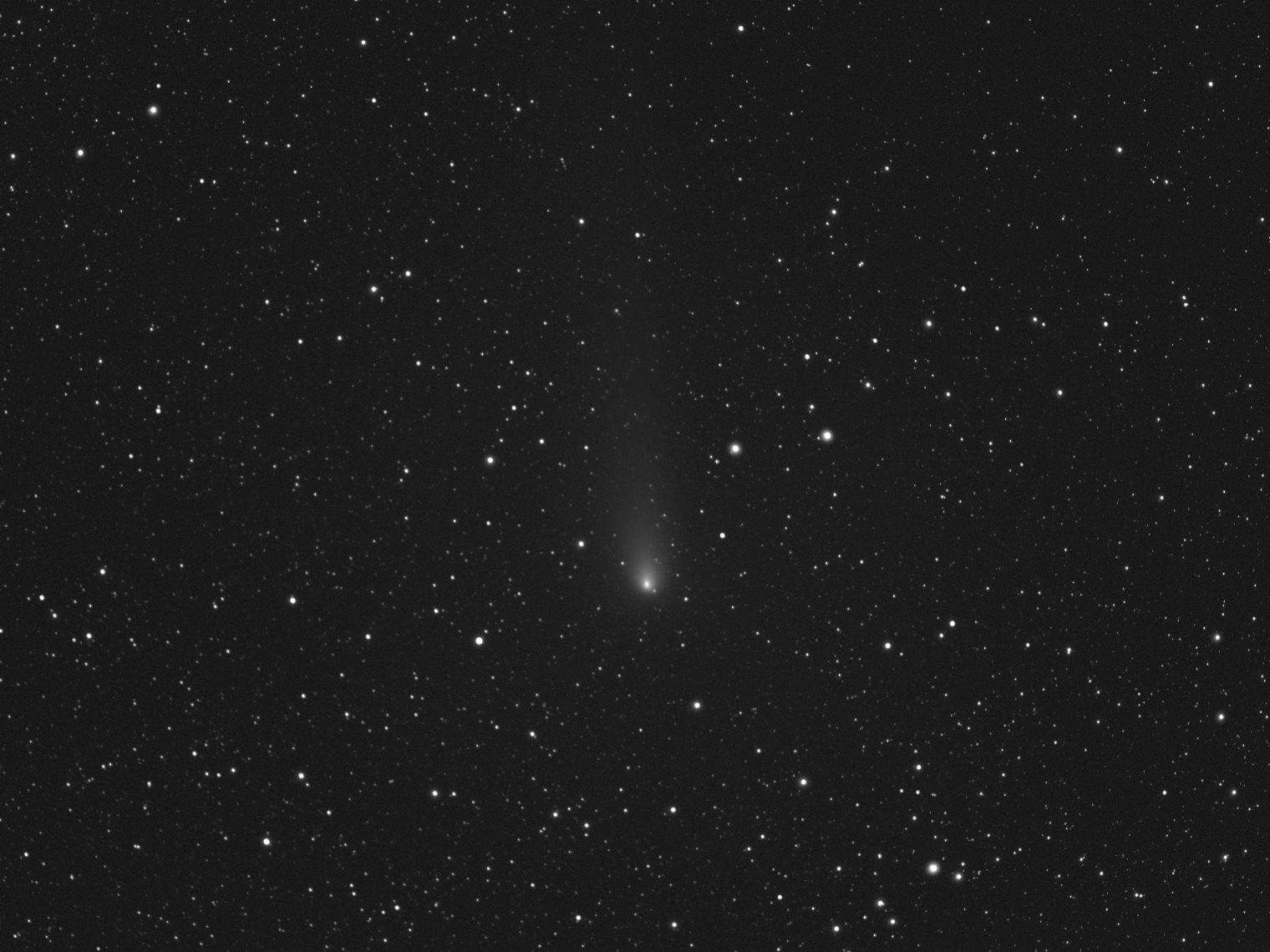
Comet Giacobini-Zinner from Cary between 5:30 and 5:45 am on Sept. 7 in a rich Auriga star field.
North is to the left.
Morning twilight had already started and a crescent moon was up low in the east.
Clouds moved in at 5:45 preventing more frames from being captured.
Unlike my last attempt at this comet, the conditions this morning were very warm and muggy.
The skies were not especially transparent, I was unable to see the comet in the scope visually.
This morning I was using my ASI1600mm-cool mono camera through the
TeleVue Genesis 4" f/5 refractor on the Celestron AVx mount.
The shots were tracked but unguided.
20 x 30s shots were taken at -10C at unity gain.
I used Maxim-DL 5 to capture the shots and ImagesPlus to reduce and stack the shots.
Two stacks were used from the same set of capture images -
one set aligned on the comet nucleus, and one set aligned on the stars.
The two sets were then aligned, masked, combined, and cropped with Photoshop.
Click on the image for a larger view in a new window.
Back to the top of the page
Back to Mark's Astrophotography Home
Comet 21P/Giacobini-Zinner and 804 Hispania animation - Sept. 7, 2018
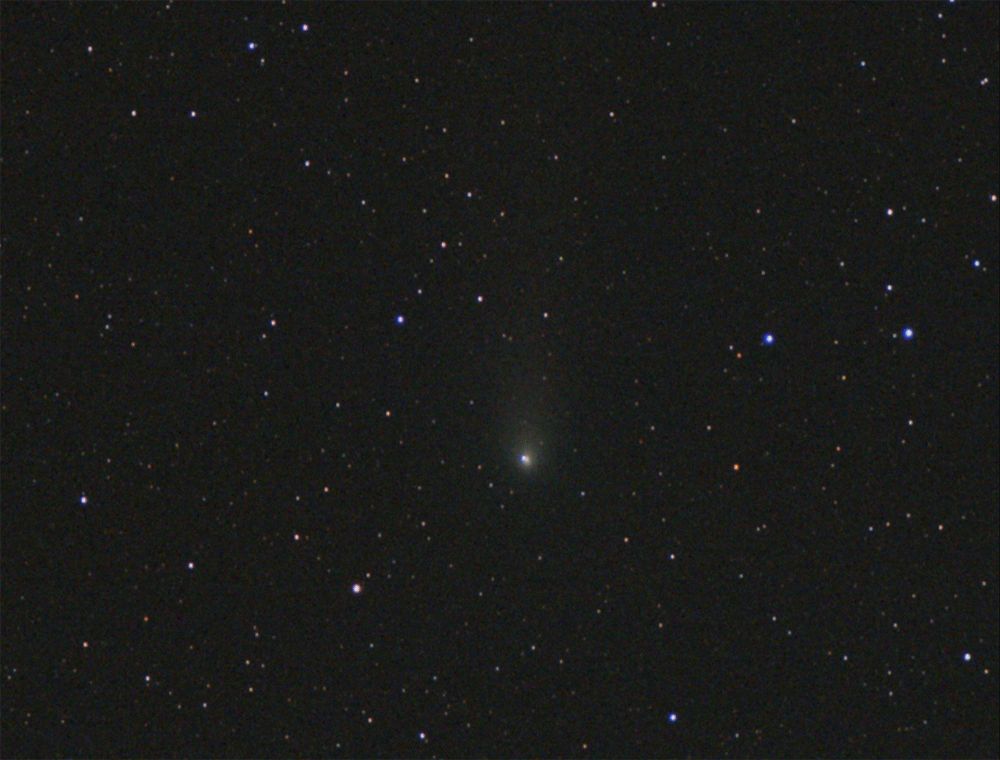
This is a 10 frame animation showing the movement of Comet 21P/Giacobini-Zinner
from 4:24 am to 4:45 am Friday morning Sept. 7.
While making the animation,
I noticed a star like object near the comet nucleus but moving at a right angle to it.
After a little research using the Minor Planet Center's web site,
I was able to determine the object was minor planet (804) Hispania at magnitude 13.3.
You can see it moving down and to the left not far left from the comet.
I had no idea at the time that the asteroid would be in my field of view.
One frame also shows a satellite passing through.
This movie was created using images captured by my Canon XTi DSLR camera and Televue Genesis telescope
mounted on my Celestron AVx mount from my front yard in Cary.
Each frame was 30 seconds long at ISO 1600.
Subframes were captured with Backyard EOS, processed with ImagesPlus,
and made into the animation using Photoshop CS2.
I only used every third frame I shot. The shots were tracked but unguided.
Click on the image for a larger view in a new window.
Back to the top of the page
Back to Mark's Astrophotography Home
Comet 21P/Giacobini-Zinner - August 24, 2018
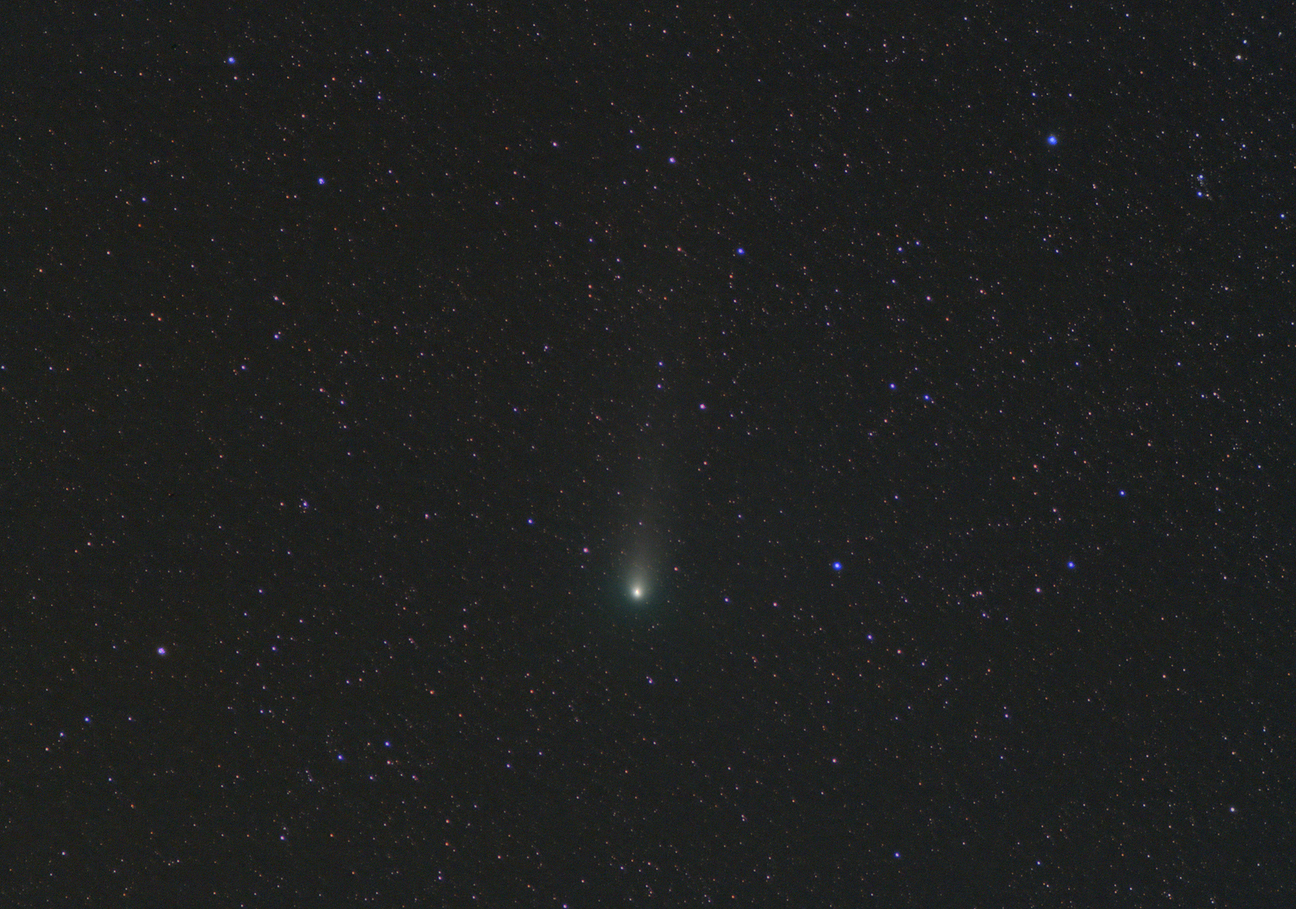
Comet Giacobini-Zinner around 5 am on August 24 in Camelopardalis.
The magnitude is around 7.2 and brightening.
This image was taken at my home in Cary, but the skies were good for August.
A cold front came through yesterday clearing the skies and lowering the humidity.
The temperature was in the upper 50s.
This is a cropped frame from my Canon Rebel XTi DSLR.
The image was made from 21 x 30 second sub-frames at ISO 1600 with darks and flats applied.
The subframes were captured with Backyard EOS and the images were
reduced and combined with Images Plus - one set centered on the comet nucleus and another
set aligned on the stars.
The two sets were then aligned with Photoshop.
The scope used was my TeleVue Genesis 4" f/5 refractor on the Celestron AVx mount.
The shots were tracked but unguided.
Click on the image for a larger view in a new window.
Back to the top of the page
Back to Mark's Astrophotography Home
Comet 46P Wirtanen and the Pleiades - Dec. 17, 2018
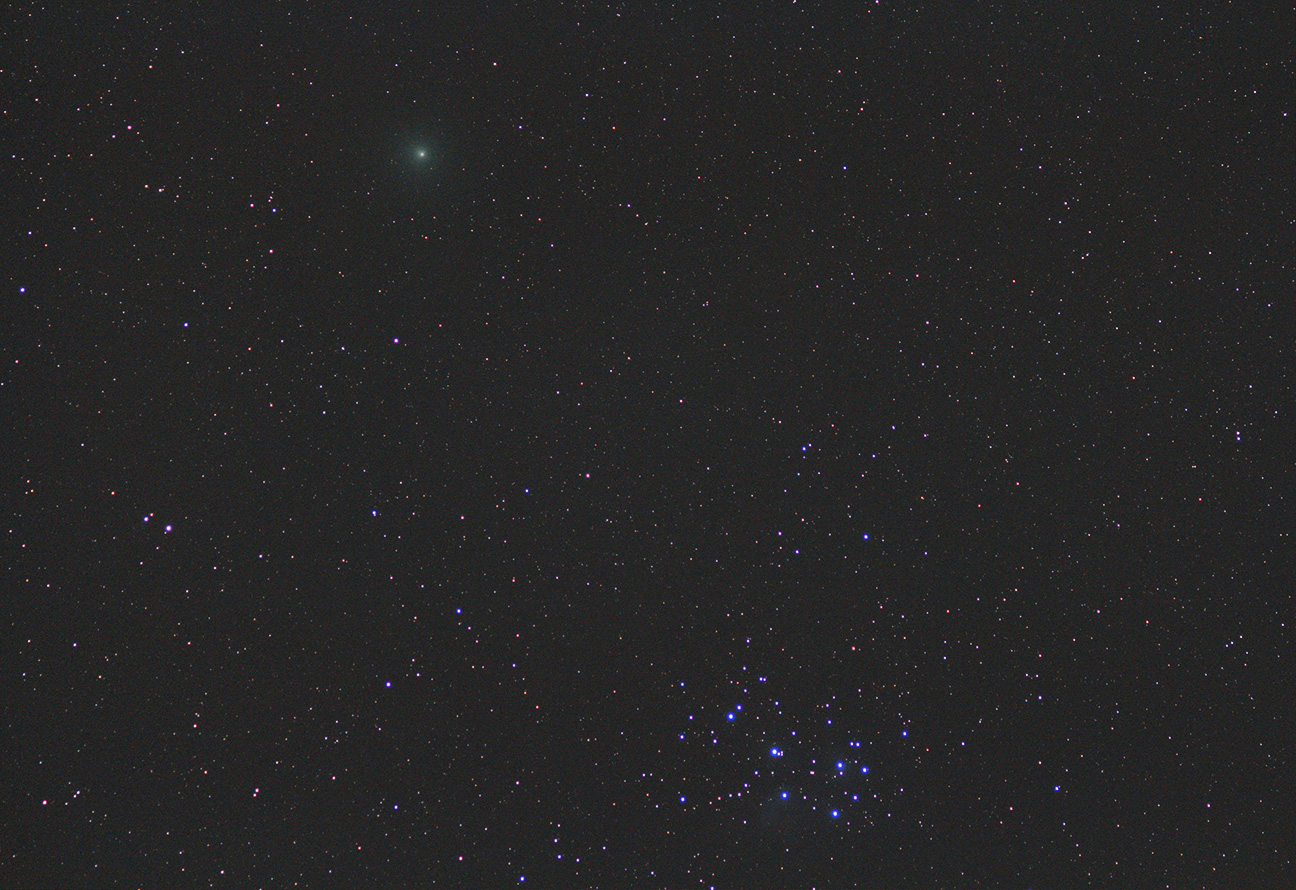
Comet 46P Wirtanen in conjunction with the Pleiades.
I stayed up until after moonset at 1:45 am to catch the comet near M45.
The image was captured from my front yard.
This photo was made with a Nikkor 135 mm lens attached to my Canon T3i while mounted on my iOptron tracker.
I used ImagesPlus to stack 6 x 10s images at ISO 1600.
Photoshop was used to crop and neutralize the background.
The comet was faintly visible through 7x50 binoculars as a large fuzzy patch.
Click on the image for a larger view in a new window.
Back to the top of the page
Back to Mark's Astrophotography Home
Comet 46P Wirtanen - Dec. 5, 2018
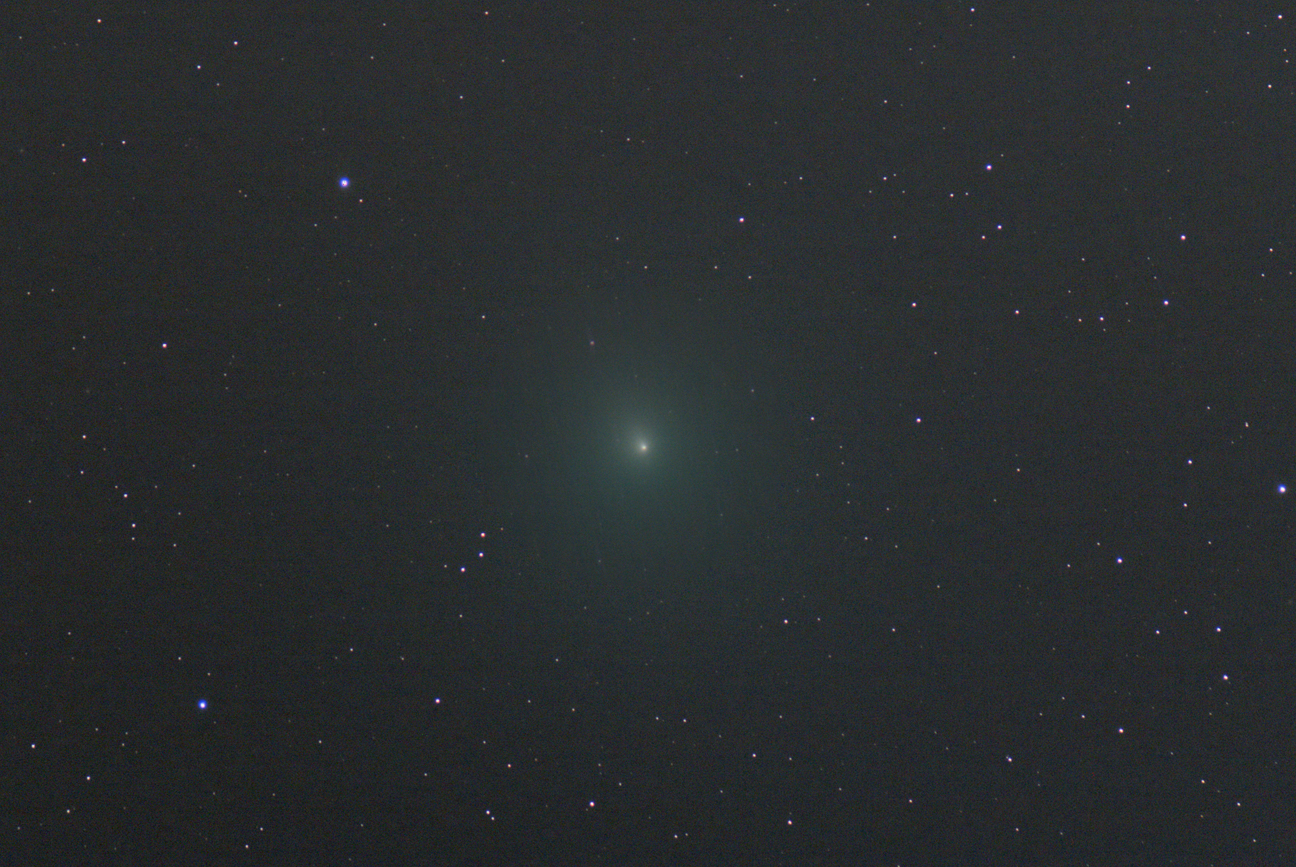
Comet 46P Wirtanen taken on Dec. 5, 2018 from 9:30 to 9:51pm. Location: Eridinus. Altitude 42 degrees.
There is a hint of a tail pointing to the upper left. Coma size is about 20 arc minutes.
Telescope: Televue Genesis 4" f/5 refractor.
Mount: Celestron AVx unguided.
Imaging Camera: Canon XTi DSLR.
Location: My front yard in Cary, NC.
Conditions: Clear and cold with temps around 40. Lots of neighborhood Christmas and porch lights on.
Exposure: 31 x 15 second lights at ISO 1600, plus darks, flats, and flat-darks.
This is a slight crop of the full frame measuring about 1.5 degrees on the diagonal.
Images were captured using Backyard EOS.
ImagesPlus was used for data reduction and stacking. Two stacks were made - one aligned on the comet nucleus and
one aligned on the stars.
Photoshop was used to take the two stacks and produce the final image.
Click on the image for a larger view in a new window.
Back to the top of the page
Back to Mark's Astrophotography Home
Comet Wirtanen and space junk - Jan. 5, 2019
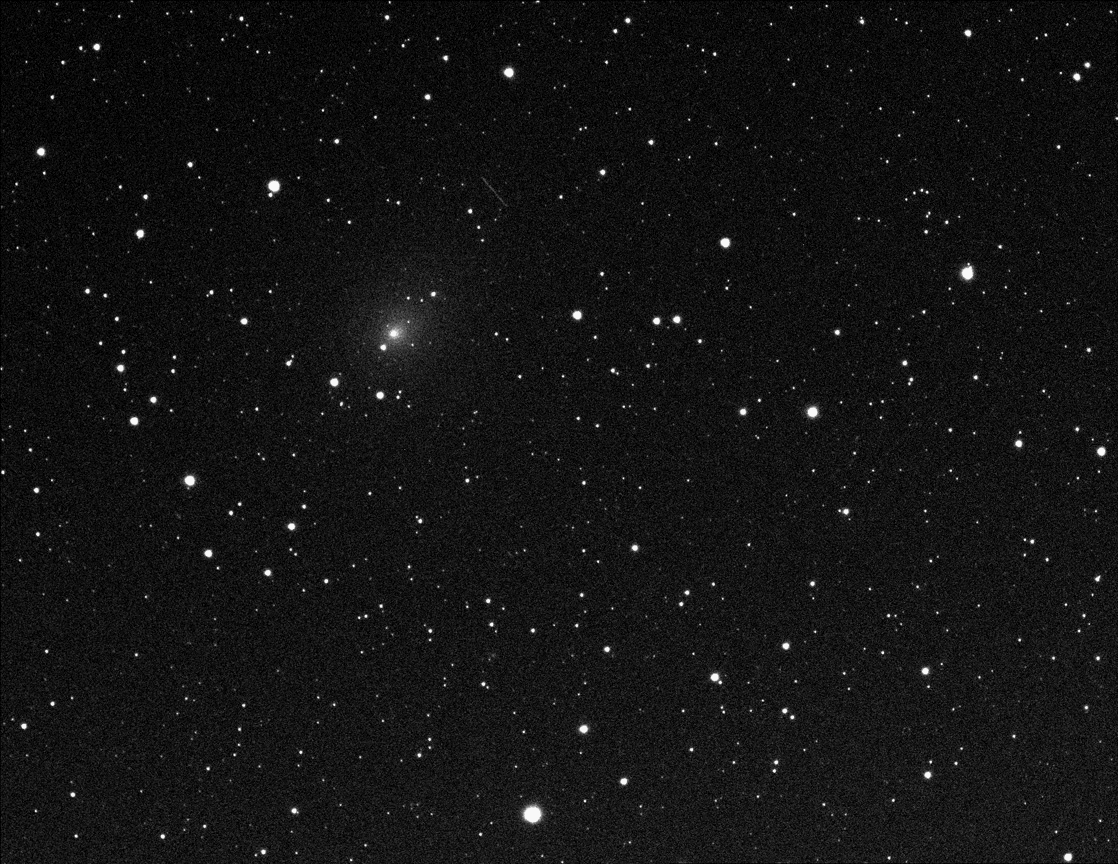
While testing out my ASI1600MM-C with a Nikkor 180mm f/2.8 lens in my front yard,
I noticed a faint trail of a passing object near Comet Wirtanen (upper left center) in my images.
A check of the minor planet center's database showed no object at the place and time of my image,
so I conclude that this is a piece of passing space junk.
Notice how the brightness varies from frame to frame implying a tumbling object.
15 exposures of 30 seconds each were used in the animation.
The animation starts at 9:24 pm EST and ends at 9:33.
North is to the left. The field of view is cropped to about 2 degrees.
Maxim DL was used to collect and reduce the data, and GIF animator was used to create the animation.
Click on the image for a larger view in a new window.
Back to the top of the page
Back to Mark's Astrophotography Home
Comet C/2018 Y1 (Iwamoto) - Feb. 14, 2019
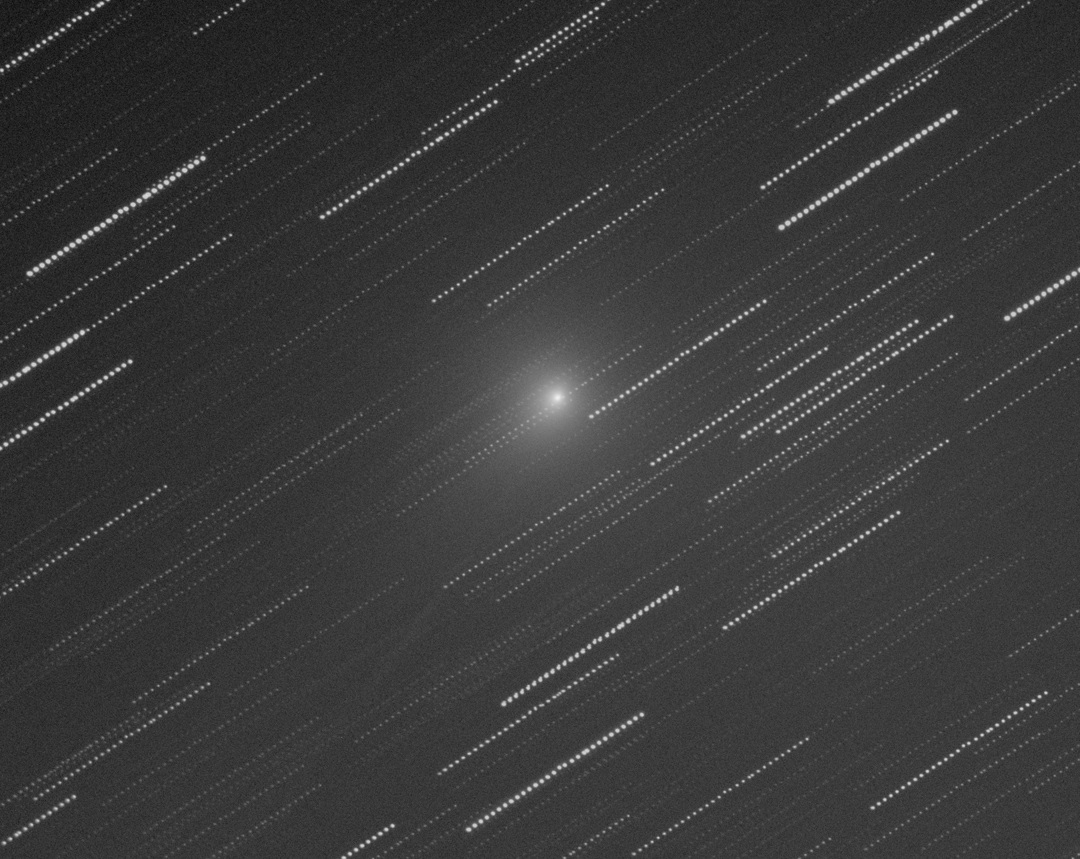
Comet Iwamoto was captured from 12:06 am through 12:50 am Thursday morning
from my front driveway in Cary NC.
Each photo was 30 seconds long followed by a 60 second pause.
The comet was moving extremely fast since it was very near Earth.
If you look carefully, a long thin tail can be seen going from the
nucleus toward the lower left of the frame.
Maxim DL was used to capture the images.
Images Plus was used to average combine and stretch the 30 comet aligned frames to show the tail.
The image shown is a crop of the center of the full ASI1600 frame.
A 63% sunlit moon was lighting up the sky making the photo fairly bright.
I was using my ASI1600mm-cool camera connected to my 4" Televue Genesis refractor.
The shots were unguided using the Celestron AVx mount.
Click on the image for a larger view in a new window.
Back to the top of the page
Back to Mark's Astrophotography Home
Comet C/2017 T2 Panstarrs and the Perseus Double Cluster Jan. 28, 2020
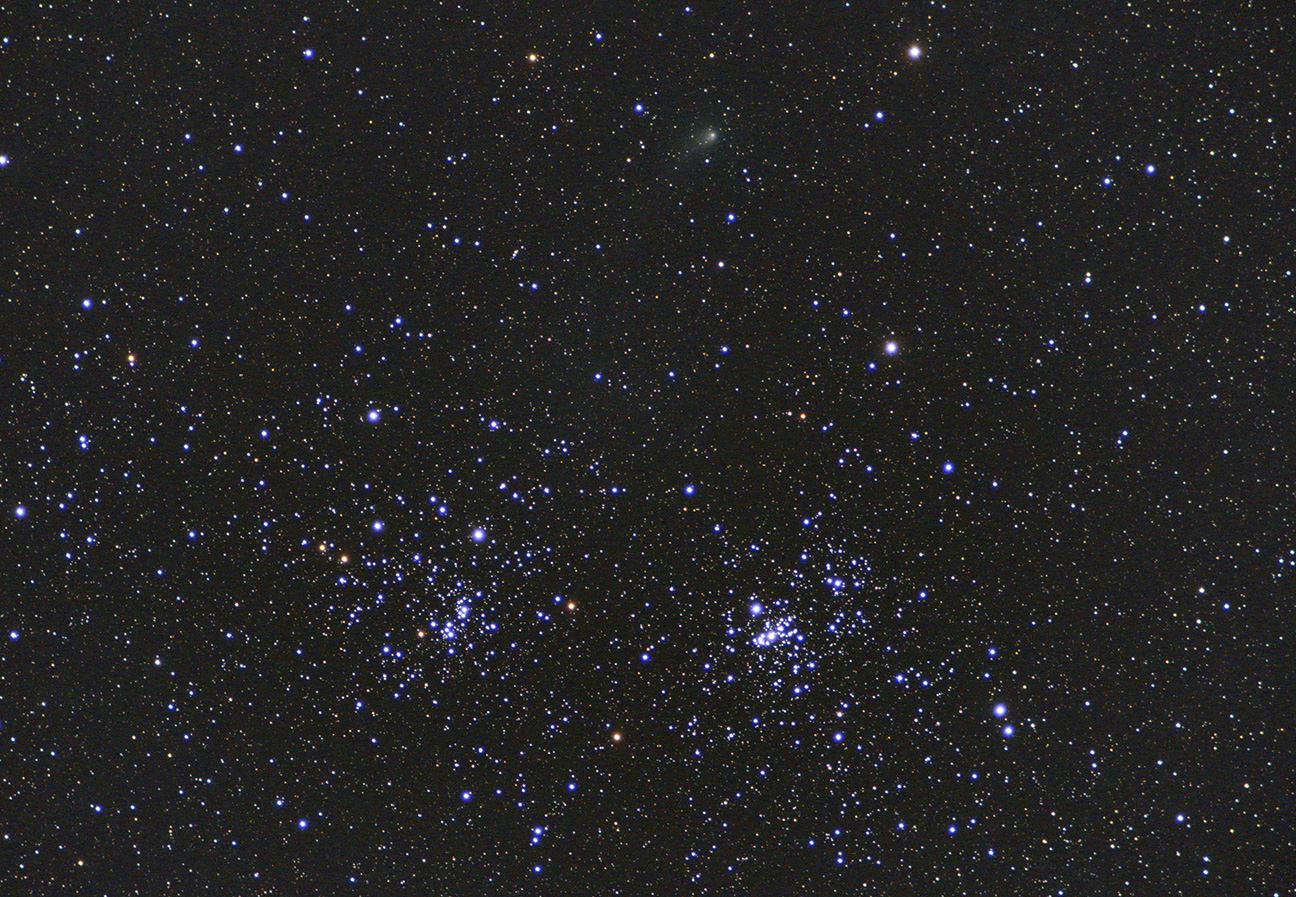
Comet C/2017 T2 Panstarrs has been moving north and west relative to the Double Cluster
(NGC 884 and NGC 869) over the last several days.
It has brightened to around mag. 9.4, but it is still pretty small.
The crescent moon brightened the cold clear skies while the shots were captured.
The field of view of the photo is cropped from the original to about 1.5 degrees
across the diagonal.
The photo is a stack of 25 x 30 second frames taken with the ASI 294 color camera
attached to my TeleVue Genesis 4" f/5 refractor.
I was using my Celestron AVx mount unguided to track the stars.
The photos were taken in my front yard in Cary NC.
The frames were captured with Astrophotography Tool then processed in PixInsight.
Photoshop CC was used for final touch-ups.
Click on the image for a larger view in a new window.
Back to the top of the page
Back to Mark's Astrophotography Home
Comet C/2017 T2 Panstarrs cruising by NGC 1528 Dec. 15, 2019
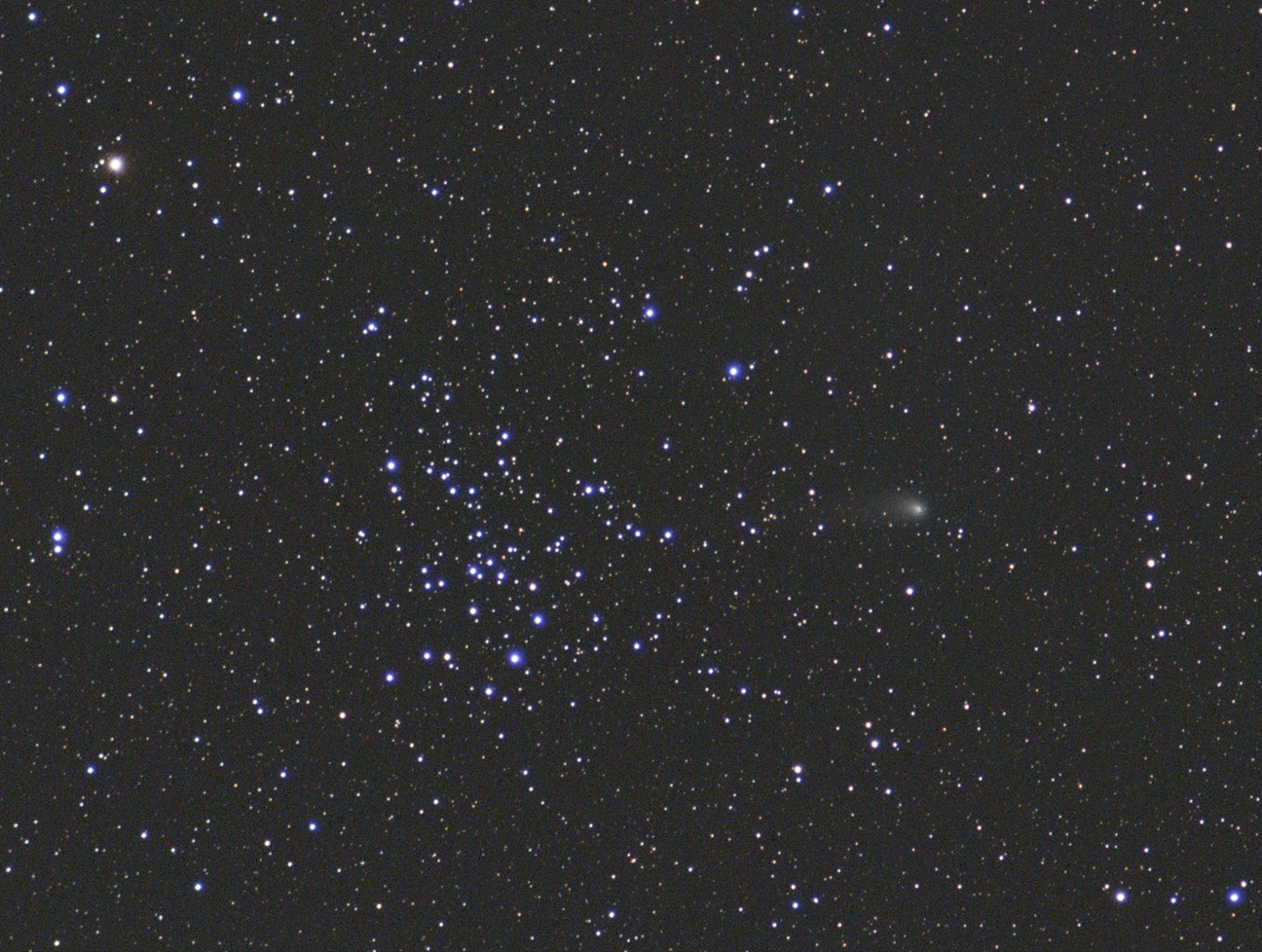
Panstarrs is a small comet with a magnitude of about 10, a coma size of around 1 arc minute,
and a tail of about 4 arc minutes pointing south.
Open cluster NGC 1528 in Perseus is listed at 18 x 18 arc minutes.
The field of view of the photo which is cropped from the original is about 1 degree
with north to the right.
The still photo is a stack of 20 x 30 second frames before the moon rose.
Click here
to see a 40 frame animation (20 mb) of Comet Panstarrs moving by
open cluster NGC 1528 in Perseus.
Each frame is 30 seconds long followed by a 2 second gap
so approximately 25 minutes of real time is compressed into about a 2 second loop.
The photos were taken in my front yard in Cary.
There were lots of street lights, porch and garage lights, and Christmas lights on around me.
The moon was above the horizon for the second half of the animation.
I used a ZWO ASI294 one-shot color camera attached to my TeleVue Genesis 4" f/5 refractor on a Celestron AVx mount.
The gain was set to 150 and the frames were unguided.
The frames were captured with Astrophotography Tools then processed in PixInsight.
The animation was made with GIF Animator.
Photoshop CC was used to finalize the still shot above.
Click on the image for a larger view in a new window.
Back to the top of the page
Back to Mark's Astrophotography Home
Comet Africano - Sept. 22, 2019

Here is another shot of Comet Africano from my front yard.
I took this one around 11 pm when the comet was higher in the sky resulting in less sky glow.
Exposures were only 30 seconds since the comet is moving pretty quickly.
Anything much longer would have produced a streaked nucleus.
No distinct tail was visible, but a diffuse glow trails to the upper left.
I also shot Comet McNaught, but it was smaller and fainter.
This image was made from my ASI1600mm mono camera connected to my TeleVue Genesis 4" f/5 refractor.
I used my Celestron AVx mount unguided.
45 x 30s subframes were averaged and cropped to produce the final result.
APT was used for image aquisition then the subframes were processed with PixInsight.
Photoshop CC was used for GradientXterminator, crop, and then convert to jpg.
Click on the image for a larger view in a new window.
Back to the top of the page
Back to Mark's Astrophotography Home
Comet PANSTARRS, M81, and M82 in Ursa Major - May 23, 2020
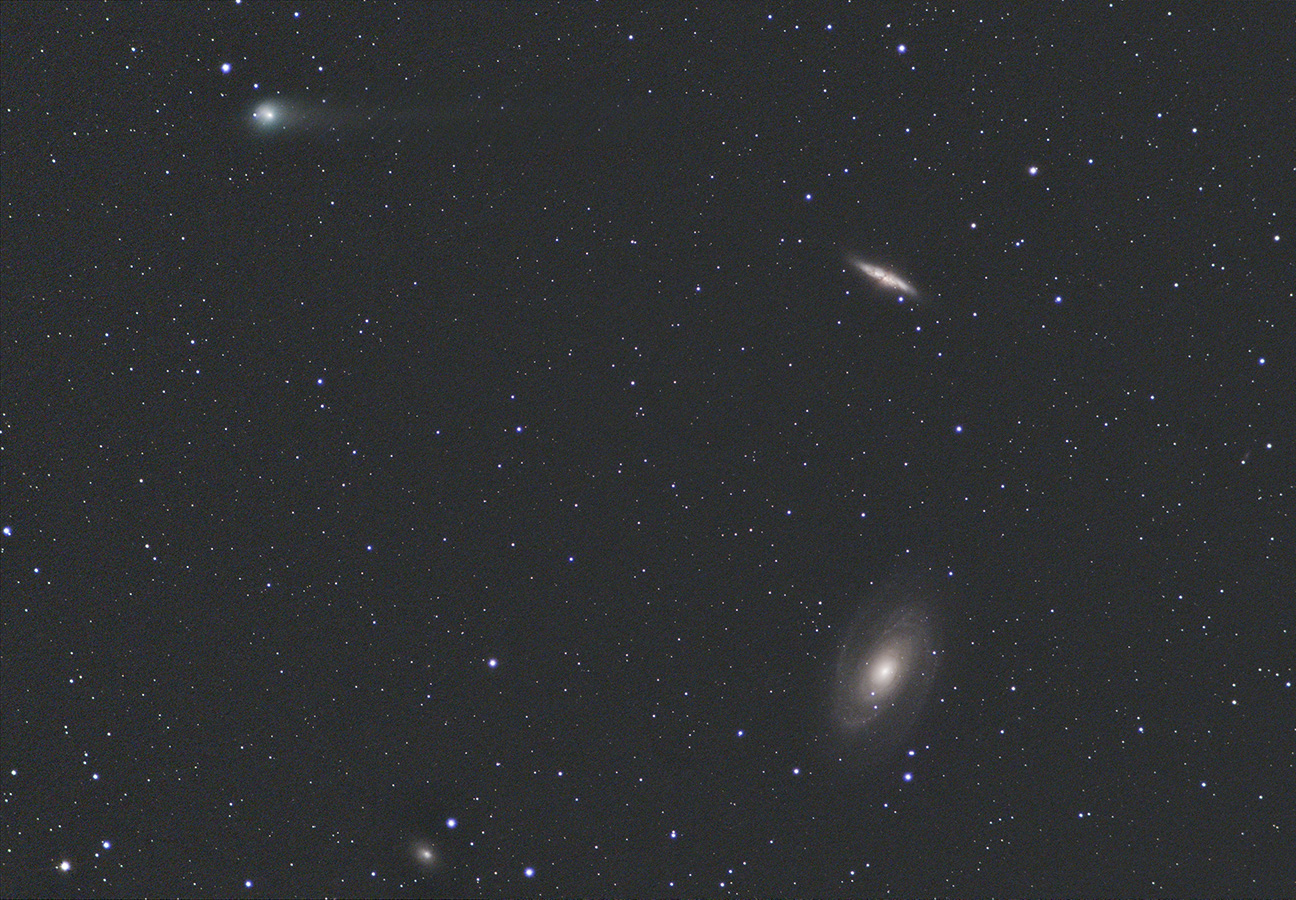
Comet C/2017 T2 PANSTARRS near bright galaxies M81 and M82.
I have been following Panstarrs for the last six months,
but it has brightened significantly recently.
I decided to image tonight at the last minute when storms to my northwest fizzled at dusk.
The image is a combination of 25 x 60 second subframes at unity gain.
The image was captured from my light polluted front driveway in Cary, NC on a warm May evening.
I was using my ZWO ASI294mc-cool camera at unity gain.
The ASI294 was attached to my TeleVue Genesis 4" f/5 refractor.
The mount used was an iOptron GEM-45, unguided.
I used APT for image capture.
PixInsight was used for image calibration, stacking of a star registered photo,
and then a comet registered photo.
The comet and star photos were then taken into Photoshop 2020 for the composite.
GradientXTerminator was used to take out some nasty gradients.
The imaged was cropped slightly.
Click on the image for a larger view in a new window.
Back to the top of the page
Back to Mark's Astrophotography Home
Comet C/2020 F3 NEOWISE - July 10, 2020
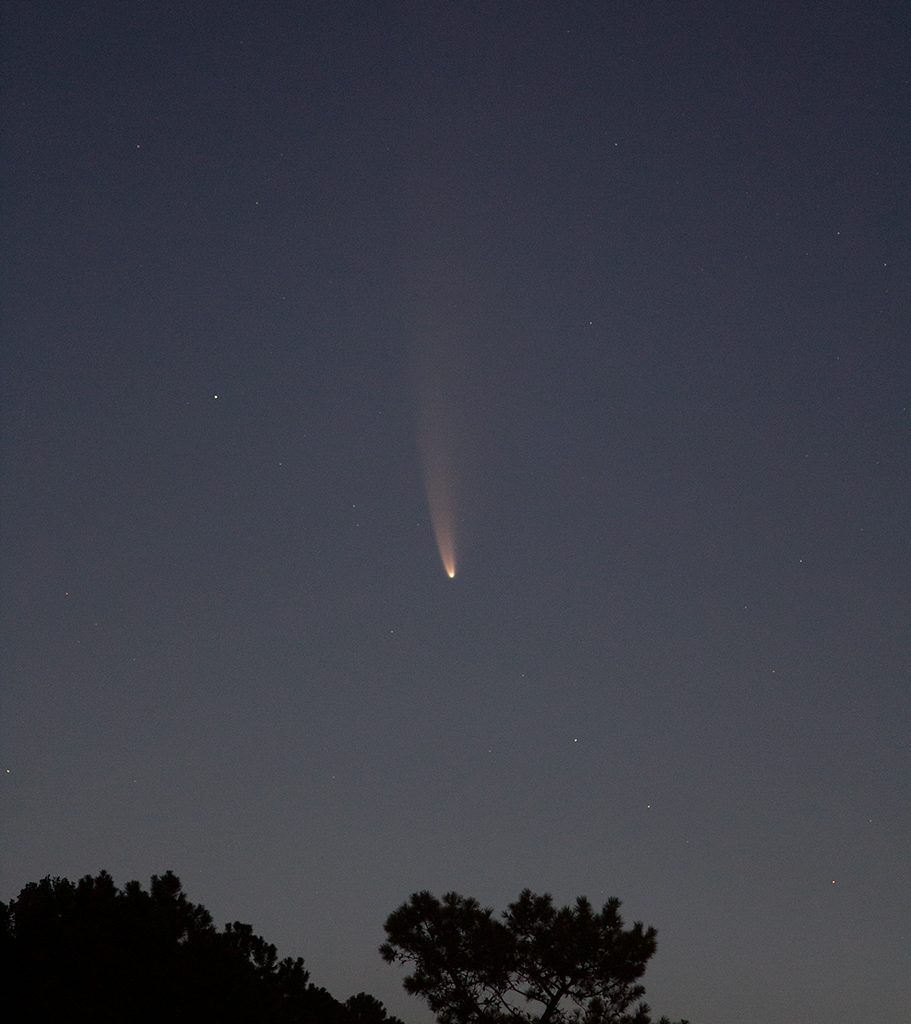
Comet C/2020 F3 NEOWISE rising in the northeast approximately 5am.
This was taken on the dam at Crabtree Lake in Cary, NC.
We noticed the tail rising above the treeline before we ever saw the nucleus.
It was an amazing sight.
The comet was visible to the naked eye, but binoculars provided a really nice view.
We followed the comet until the sky became to bright due to morning twilight.
I used a tripod mounted Canon T3i and a Nikkor 180mm f/2.8 lens wide open.
The exposure was 0.7 second at ISO 1600.
The frame was cropped at the top and bottom.
Back to the top of the page
Back to Mark's Astrophotography Home
NEOWISE Rising - July 10, 2020
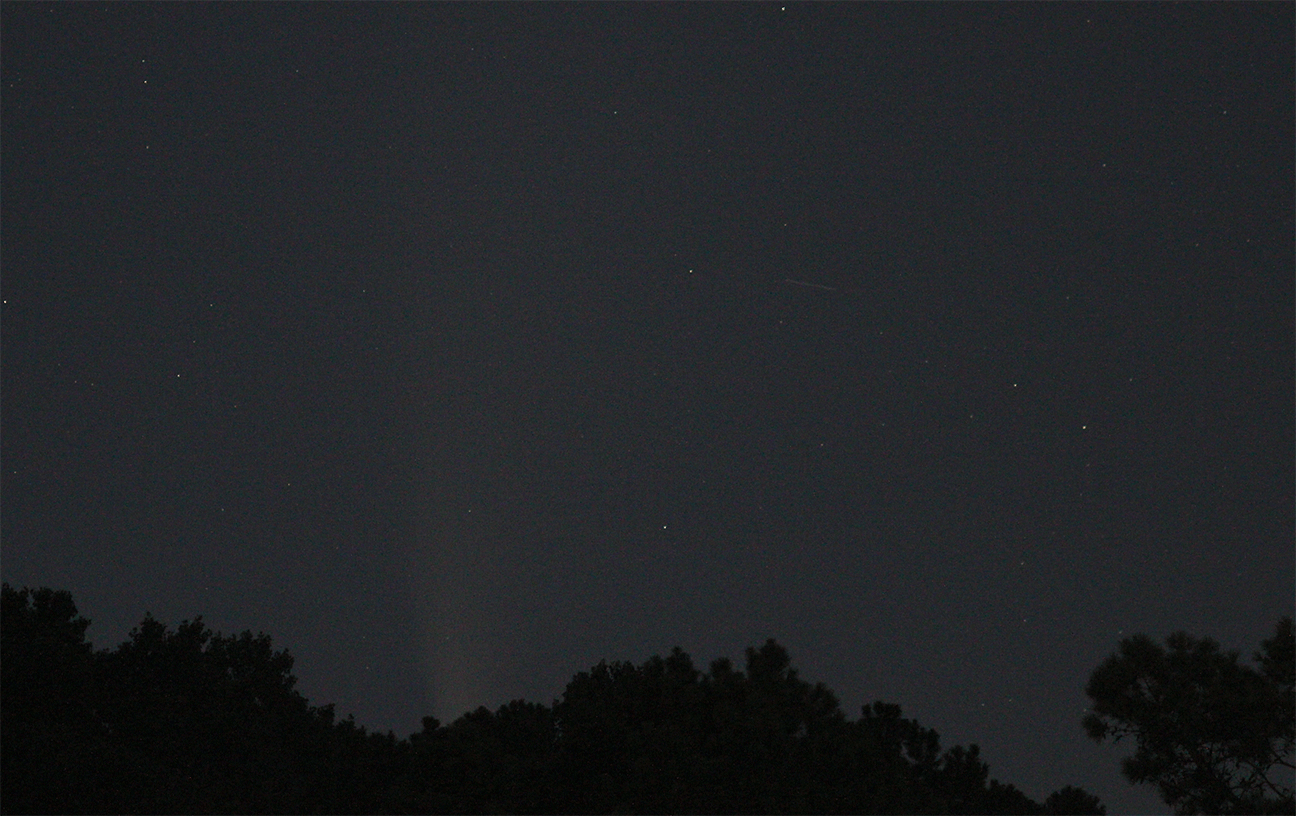
Comet C/2020 F3 NEOWISE rising from behind the trees as seen from
the Crabtree Lake dam in Cary, NC.
Scroll up to see a single frame taken a few minutes later as the sky brightened.
This three exposure sequence was taken from around 4:42am to 4:49am.
We were able to see this clearly through 7x50 binoculars.
I used a tripod mounted Canon T3i and a Nikkor 180mm f/2.8 lens wide open.
Each exposure was 1 second at ISO 1600.
The photos were cropped before inserting them into the animation.
Photoshop CC was used to align the frames and then make the animation.
Click on the image for a larger view in a new window.
Back to the top of the page
Back to Mark's Astrophotography Home
Comet C/2020 M3 ATLAS in Orion - Nov. 8, 2020
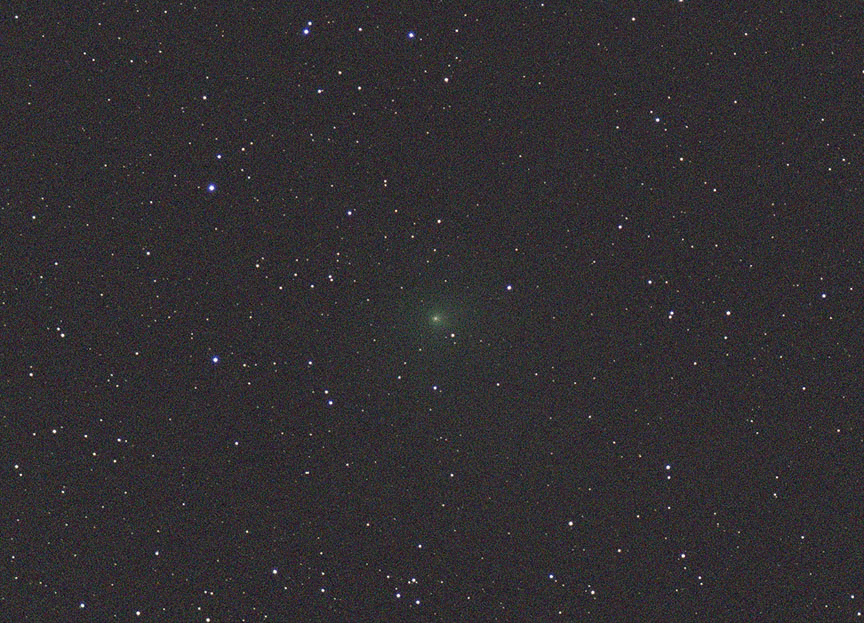
The frames of this animation of Comet ATLAS were taken just after midnight on Sunday Nov. 8, 2020.
At the time, the comet was cruising northward among the stars of Orion just 3.5 degrees west of the Orion Nebula.
It was reasonably bright (at least for a comet) at magnitude 8.0.
Making things more challenging, the 55% illuminated Moon was 60 degrees away from the comet
and the altitude of the comet was only about 30 degrees high in the east.
Present as always was the light pollution near my house in the Cary NC area.
This 22.5 minute long animation was made from 30 subframes at 45 seconds long each.
The field of view is just over 1 degree across the diagonal.
The subframes were taken through my 4" f/5 TeleVue Genesis refractor and my ASI294MC camera at gain 150.
The telescope was mounted on an iOptron GEM-45 mount.
The shots were tracked but unguided.
The images were captured with APT software.
PixInsight was used to apply dark and flat frames to all the light frames
then to align each frame on the stars.
The frames were cropped with the comet roughly centered and then stretched
and converted to jpg images.
At that point, Photoshop CC was used to remove the gradients present,
then to adjust the contrast and color balance.
Finally, GIF Animator was used to creat the gif animation.
For a larger view in a new window, click on the image.
Back to the top of the page
Back to Mark's Astrophotography Home
Comet C/2020 R4 (Atlas) in Hercules - April 16, 2021
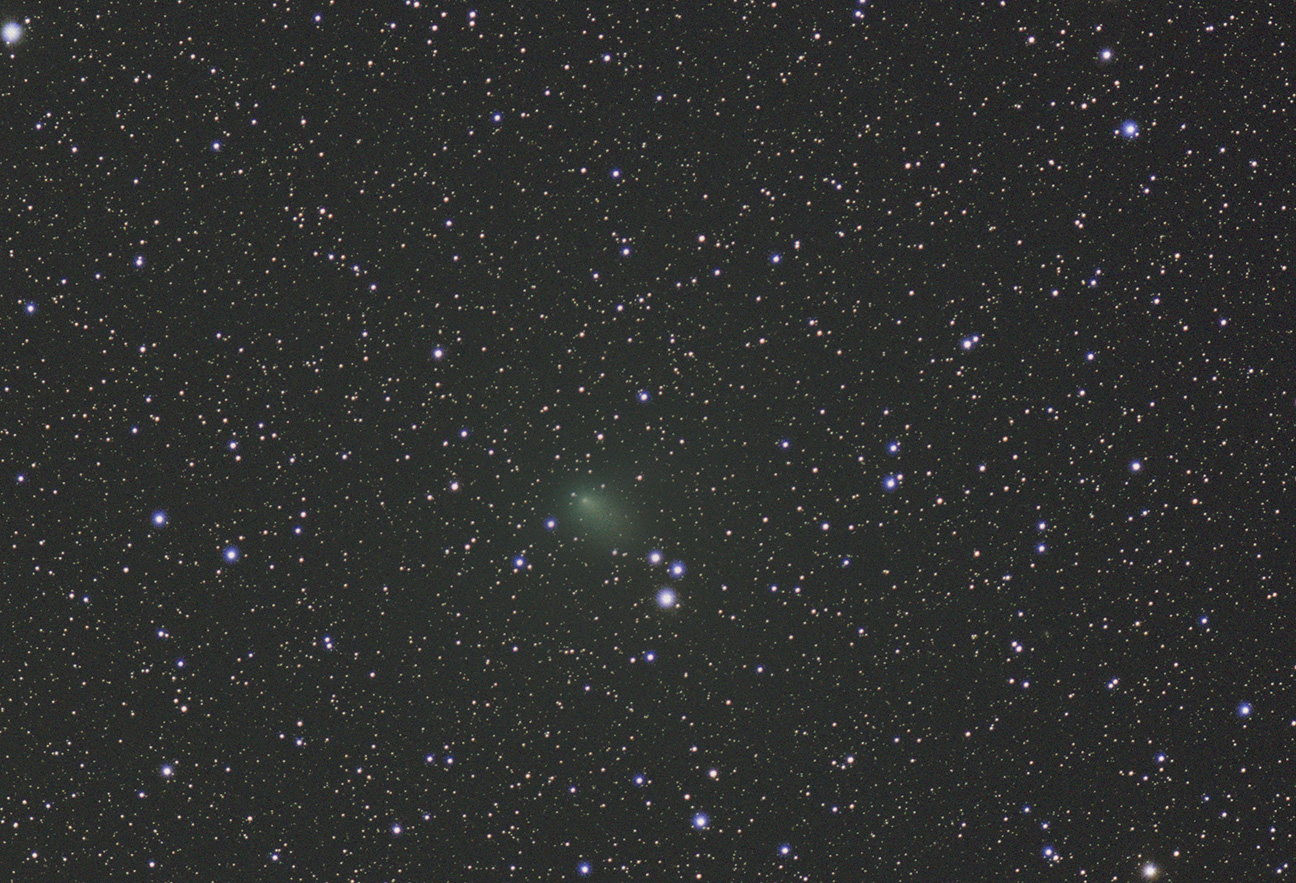
Comet C/2020 R4 Atlas in the constellation of Hercules.
I got up at 3am to set up and photograph this one!
The comet was somewhere around magnitude 8.5 to 9.
It was also moving very fast since it was within a week to it's closest point to Earth.
Each update to computer display showed obvious movement.
Over the hour and six minutes I photographed it, the comet moved just under 10 arc minutes.
North is to the top in this image.
The image has been cropped to about 50% of the original frame.
Location: Cary, NC in my front yard
Camera: ASI294MC-pro gain:150
Exposures: 38 x 45 sec with a 45 second gap between exposures
Filter: none
Scope: Televue Genesis 4" f/5 refractor
Mount: iOptron GEM-45
Guider: none
Capture software: APT
Guiding software: none
Processing software: Pixinsight and Photoshop
Notes: Pixinsight was used for data reduction, align, stack, scnr, and convert to tiff.
Two stacks were made - one on the stars and one on the comet.
The two stacks were taken into Photoshop CC and combined together with a mask
over the comet in the comet aligned stack.
Levels, crop, and convert to jpg were also done.
For a larger view in a new window, click on the image.
Back to Mark's Astrophotography Home
Comet C/2021 A1 Leonard passing by M3 - Dec. 3, 2021
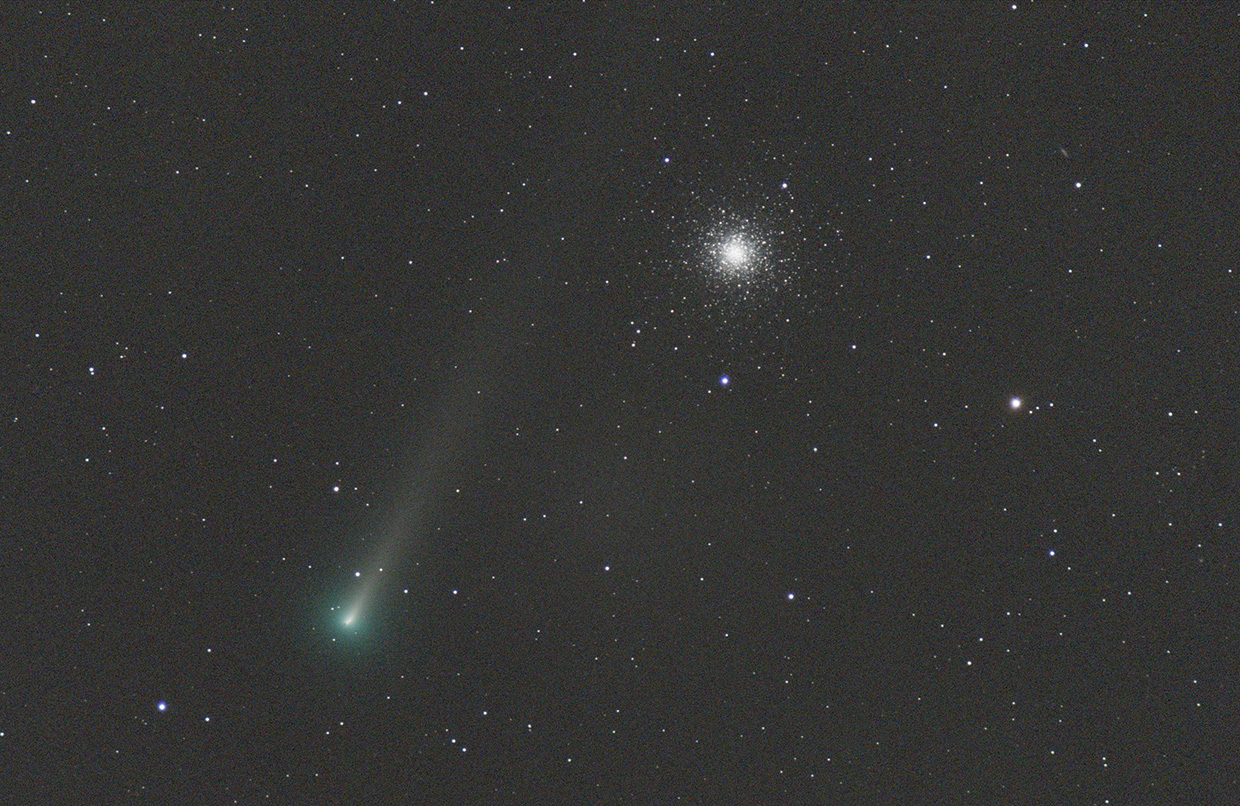
Comet C/2021 A1 Leonard passes by globular cluster M3 and a small galaxy.
This photo showes Comet Leonard which is a solar system object,
globular cluster M3 a galactic object,
and the small galaxy NGC-5263 to the upper right of M3 which is extra-galactic.
The photo is only aligned on the stars so the comet's fast motion shows
slight streaking around the nucleus.
For a larger view in a new window, click on the image.
Details:
Location: Front yard Cary, NC
Camera: ZWO ASI294MC-Pro
Exposure: 8x45sec subs at gain 150
Filter: none
Scope: TeleVue Genesis 4" f/5
Mount: iOptron GEM-45
Guider: none
Capture software: APT
Guiding software: none
Calibration frames: 13 flats and 13x45s darks
Processing software: PixInsight and Photoshop
Notes:
High clouds were a problem during the subframe capture.
In all, I took 45 x 45s light frames, but I only used the 8 taken closest to dawn.
These frames were cropped and then integrated into a master frame.
The master frame was then color calibrated and saved as a tiff file.
My original intent was to make a star aligned master and a comet aligned master and
combine them, but this proved to be very difficult.
Photoshop and GradientXterminator were used to remove the gradient, change the levels,
and produce the jpg from the tiff file.
Back to Mark's Astrophotography Home
Comet C/2017 K2 (Panstarrs) in Ophiuchus, July 17, 2022
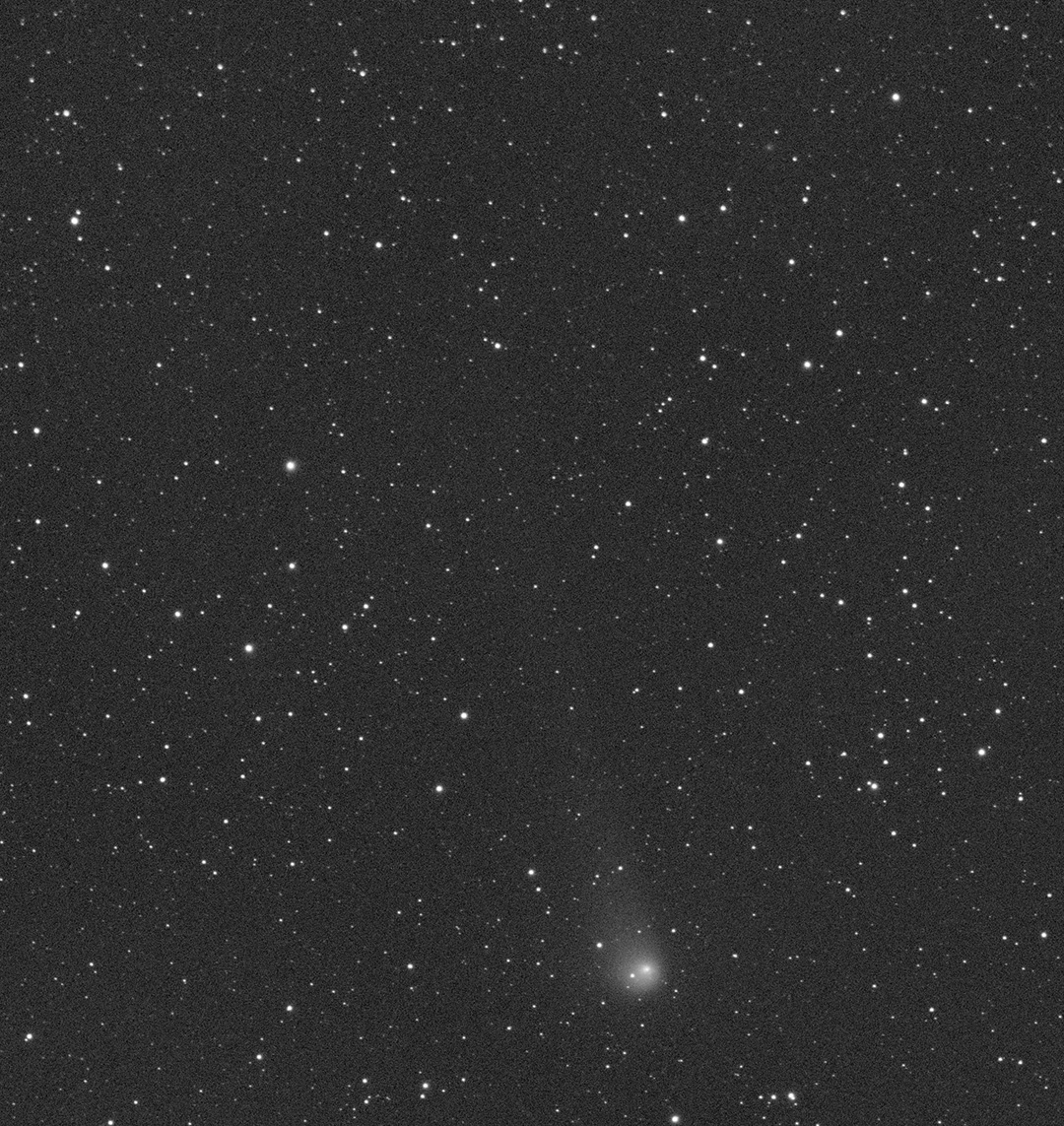
This is a mono version of C2017 K2 (Panstarrs) I shot while testing out my new ASIair.
The comet was setting behind some trees across the street from me so I only got 5 x 60s shots.
Since I was only testing things out, I was using my ASI1600mm with no filters and no guiding.
The image was cropped and the vertical size is about 1 degree long.
Notice the star next to the nucleus making it look almost like a double nucleus.
North is at the top of the photo.
Details:
Location: Front yard Cary, NC
Camera: ASI1600mm-Pro
Exposure: 5 x 60s gain 139
Filter: UV/IR
Scope: Televue Genesis 4" f/5 refractor
Mount: iOptron GEM-45
Guider: none
Capture software: ZWO ASIair Plus
Guiding software: none
Calibration frames: darks, flats, flat-dark
Processing software: Pixinsight, Photoshop CC
Weather conditions: Warm!
Back to Mark's Astrophotography Home